
Have you heard Maamme (“Our Land”), Finland’s national anthem? All Finns know at least the first verse of their kansallislaulu (“national anthem”) by heart. The song provides a fascinating glimpse into the Finnish mindset at a pivotal time in the nation’s history. And for a language learner, reading or listening to the 19th century lyrics is an interesting challenge to take on!
Don’t let the difficulty of it put you off, though – we will introduce you to the main themes and the key vocabulary to help you make sense of the Finnish lyrics. In this article, we’ll also shed light on the interesting history and evolution of the Finnish national anthem as well as its present-day status.
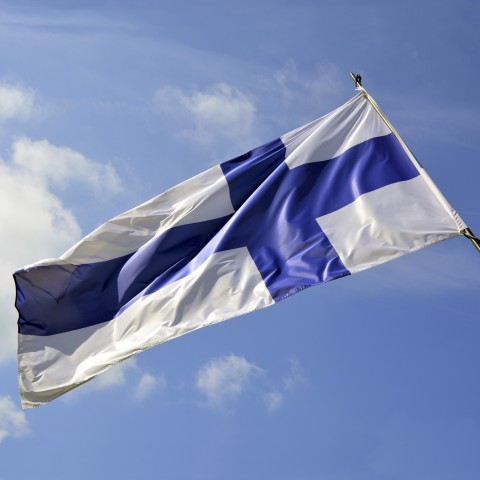
siniristilippu (“the flag of Finland”, literally: “blue cross flag”)
 Table of Contents
Table of Contents
- From Poem to National Anthem
- The Finnish Lyrics of Maamme
- When is it Played?
- Controversies
- How FinnishPod101 Can Help You Learn More Finnish
1. From Poem to National Anthem
A- The Lyrics
The story of Maamme begins in 1846, just a couple of years before the turbulent political upheavals of the Springtime of the Peoples shook Europe. This is when Finland’s national poet, Johan Ludvig Runeberg, penned a patriotic poem in Swedish titled Vårt land (“Our Land”). This poem would eventually become the Finnish national anthem’s lyrics.
The poem appeared as the prologue to Runeberg’s collection of heroic ballads, The Tales of Ensign Stål. These stories describe the events of the War of Finland that led to the country’s secession from Sweden and its establishment as an autonomous grand duchy of Russia in 1809. Although Finland wasn’t an independent country at the time, the sense of nationhood was on the rise, and Runeberg intended to stir these feelings further with his poem.
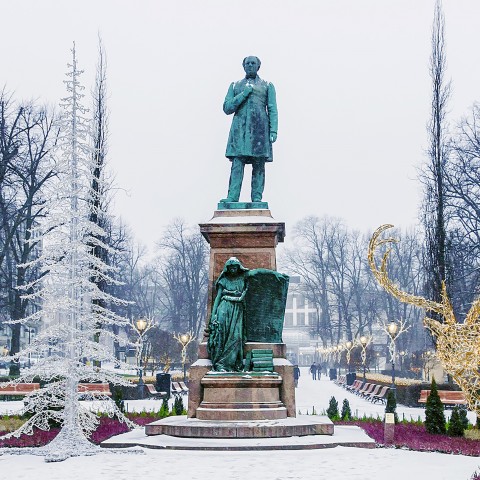
Statue of J. L. Runeberg, Helsinki
B- The Melody
Runeberg himself composed a melody for his poem, as did several others. However, it wasn’t until Fredrik Pacius, a German-born composer and music teacher at the University of Helsinki, got involved that Runeberg’s poem took off as a song. Pacius was tasked to compose a melody for Vårt land for the students’ Flora Day celebrations in May 1848. Allegedly, the composer did so with a light hand, intending to create a cheerful tune suitable for the lively springtime celebration. It is also said that he had only a couple of days to finish his composition and prepare the choir and musicians to perform it. His work was well received, though, with the audience eagerly requesting to hear the song again and again.
Today, a memorial stands at the site commemorating the first-ever performance of the national anthem.
C- The Finnish Translation
Over time, many people have translated Vårt land into Finnish. The established Finnish language text is often attributed to Paavo Cajander, who translated The Tales of Ensign Stål into Finnish in 1889. His work, in turn, is said to be based on an earlier translation of Runeberg’s poem by a group of poets led by Julius Krohn in 1867.
Translating the poem from Swedish into Finnish posed some challenges to all who took on the task. For example, in Runeberg’s original Swedish text, many of the lines begin and end with monosyllabic words which are common in Swedish but not in Finnish.
D- Position as the National Anthem
Maamme gained its position as the national anthem gradually and organically. Student choirs adopted the song with enthusiasm and in Finnish schools it was the most popular song taught to pupils for over a decade. The song was also a part of many official events, and was performed during the visits of the Russian emperors Alexander II in 1856 and Alexander III in 1885.
After Finland gained its independence in 1917, Maamme became the anthem of the “Whites” in the Finnish Civil War of 1918. Their opponents, the “Reds”, would sing the International and the Marseillaise. After a White victory, the position of Maamme as an anthem for the whole nation became stabilized. The Winter War (1939 – 1940) cemented the status of the song: it was played on the radio every night after news from the front and was a fixture at all patriotic events during the conflict.

Finnish students played an important role in the history of the Finnish national anthem.
2. The Finnish Lyrics of Maamme
Maamme consists of 11 verses. Distinct themes are evident; the anthem explores the Finns’ love for the beauty of their land, looks back at the hardships and tribulations their ancestors lived through, and ends with a high note of optimism and hope for the future. It’s also notable that Maamme is very peaceful in its message. The lyrics emphasize patience, humility and being satisfied with one’s lot rather than revolutionary sentiments. The Finnish anthem praises the Finns’ ability to find happiness in what they have, however little that may be.
The line-by-line English translation below is as literal as possible to help you understand the somewhat archaic Finnish lyrics! You can find the original Swedish lyrics as well as the modern English adaptation on Wikipedia.
Beware: in poetry and songs, the typical word order of standard Finnish is often reversed! For example, you’ll find many instances of an adjective placed after a noun in these verses.
Take a look at the following vocabulary too before you dive in! Keep an eye out especially for the many variations of the words “country” and “dear” in the lyrics.
- maa (“country”, “land”, “ground”, “soil”)
- maailma (“world”)
- synnyinmaa (“birth country”)
- kotimaa (“home country”)
- isänmaa (“fatherland”, “home country”)
- isä (“father”, “forefather”, “ancestor”)
- kansa (“people”, “nation”)
- kallis (“dear”, also: “expensive”)
- kultainen (“dear”, “golden”)
- rakas (“dear”, “beloved”)
- armas (“dear”, “cherished”)
Verse 1
| Oi maamme, Suomi, synnyinmaa, soi, sana kultainen! Ei laaksoa, ei kukkulaa, ei vettä rantaa rakkaampaa, kuin kotimaa tää pohjoinen, maa kallis isien! | Oh our land, Finland, country of birth rings the dear word! No valley, no hill, no water more beloved, than this Northern homeland, dear country of fathers’! |
Verse 2
| On maamme köyhä, siksi jää, jos kultaa kaivannet Sen vieras kyllä hylkäjää, mut meille kallein maa on tää, sen salot, saaret, manteret, ne meist on kultaiset. | Our country is poor and so remains, if you crave gold A stranger will surely reject it, but for us this is the dearest country, its forests, islands, lands we hold them dear. |
Verse 3
| Ovatpa meille rakkahat koskemme kuohuineen, ikuisten honkain huminat, täht’yömme, kesät kirkkahat, kaikk’kuvineen ja lauluineen mi painui sydämeen. | They’re beloved to us our rapids gushing, the hum of eternal pines, our starry nights, bright summers, all the sights and sounds that are buried in the heart. |
Verse 4
| Täss auroin, miekoin, miettehin isämme sotivat, kun päivä piili pilvihin tai loisti onnen paistehin, täss Suomen kansan vaikeimmat he vaivat kokivat. | Here with plows, swords, thoughts our fathers waged war when the day hid in the clouds or shone with the light of happiness, here the direst for the people of Finland they experienced. |
Verse 5
| Tään kansan taistelut ken voi ne kertoella, ken? Kun sota laaksoissamme soi, ja halla näläntuskan toi, ken mittasi sen hurmehen ja kärsimykset sen? | The battles of this nation who can recount, who? When war in our valleys rang, and frost brought the pain of hunger, who measured its blood and its suffering? |
Verse 6
| Täss on sen veri virrannut hyväksi meidänkin, täss’ iloaan on nauttinut ja murheitansa huokaillut se kansa, jolle muinaisin kuormamme pantihin. | Here has its blood been shed for our benefit too, here has rejoiced and its sorrows sighed that nation, upon which our most ancient burden was put. |
Verse 7
| Tääll’ olo meill on verraton ja kaikki suotuisaa, vaikk onni mikä tulkohon, maa isänmaa se meillä on. Mi maailmass on armaampaa ja mikä kalliimpaa? | Here we feel wonderful and everything is favorable, whatever fortune may come, we have our fatherland. What in the world is more cherished and what dearer? |
Verse 8
| Ja tässä, täss’ on tämä maa, sen näkee silmämme. me kättä voimme ojentaa ja vettä rantaa osoittaa ja sanoa: kas tuoss’ on se, maa armas isäimme. | And here, here is this land, our eyes see it. we can stretch our hand and point at water, shore and say: look right there it is, the beloved country of our fathers. |
Verse 9
| Jos loistoon meitä saatettais vaikk’ kultapilvihin, mis itkien ei huoattais, vaan tärkein riemun sielu sais, ois tähän köyhään kotihin halumme kuitenkin. | If into glory we were ushered even to clouds of gold, where there’s no crying or sighing, rather the most important joy for the soul to gain, it would be for this poor home our desire nonetheless. |
Verse 10
| Totuuden, runon kotimaa maa tuhatjärvinen miss’ elämämme suojan saa, sa muistojen, sa toivon maa, ain ollos, onnees tyytyen, vapaa ja iloinen. | The home country of truth, poetry the land of a thousand lakes in which our life finds shelter, you land of memories, you land of hope, always satisfied with your fortune, free and glad. |
Verse 11
| Sun kukoistukses kuorestaan kerrankin puhkeaa, viel lempemme saa nousemaan sun toivos, riemus loistossaan, ja kerran, laulus synnyinmaa korkeemman kaiun saa. | Your blossom from its bud will burst out for once it’ll yet raise our love your hope, your joy in its splendor and once, your song oh country of birth a higher echo will gain. |
You can listen to Maamme on YouTube:

The beauty of the Finnish nature is an important theme in the national anthem.
3. When is it Played?
Today, Finnish children continue to learn and sing Maamme in school. The Finnish national anthem is also an important part of Independence Day celebrations on the 6th of December, and the song is played at international sporting events, such as the Olympics, when a Finnish athlete or team wins gold.
When the anthem is sung at an event, it’s customary to sing the first and the last verse of the song. This custom is said to originate in Taavi Hahl’s 1871 collection of male choir songs, which included only these two verses. On formal occasions, the anthem is sung in both Finnish and Swedish.
- Jääkiekko (“ice-hockey”) is one of the most popular Olympic sports in Finland. Learn the Finnish names of other important sports on the Talking About Olympic Sport vocabulary list.

Candles and Maamme are important parts of Finnish Independence Day celebrations.
- Find out How to Celebrate Finnish Independence Day like a Finn – also on the FinnishPod101 Blog – and learn important Finnish Independence Day vocabulary.
4. Controversies
Maamme does not have an official, legally defined status as the national anthem of Finland (unlike other national symbols like the Finnish flag). This has left plenty of room for discussion, and Finnish people have expressed opinions both for and against keeping their unofficial anthem.
Some of the criticism directed towards Maamme includes the assertion that the song isn’t ‘Finnish enough’ due to the fact that the lyrics were originally written in Swedish and the melody was composed by a German immigrant. Some have deemed the lyrics too passive in nature and call for a national anthem that reflects a more vigorous brand of nationalism. Some are bothered by the fact that the unofficial national anthem of Estonia, Mu isamaa, mu õnn ja rõõm (“My Fatherland, My Happiness and Joy”) uses the same melody composed by Pacius.
Other songs have been put forward to replace Maamme over the years. The most popular contender has been Finlandia-hymni (“Finlandia Hymn”). Jean Sibelius’ celebrated composition has been proposed multiple times and several citizens’ initiatives have been launched to set it as the official national anthem of Finland. However, Maamme remains popular and has its own staunch supporters; some Finns have called for a vote to make its position undisputed by law.
- What do you think? Whoever you side with, be sure to learn Must-Know Expressions for Agreeing and Disagreeing in Finnish!

Maamme captured the hearts of Finns over time.
5. How FinnishPod101 Can Help You Learn More Finnish
In this guide, we’ve covered a lot of information about the Finnish national anthem, Maamme. We’ve learned about its origins, explored its themes and lyrics, and discussed its status in Finland today. How does the national anthem of Finland compare to the national anthem of your country? Share your thoughts and observations with us in the comments below!
If you want to learn more about Finland, visit FinnishPod101 and browse through our extensive lesson library – our teaching material combines grammar topics with cultural insights to make learning fun and engaging. Don’t forget to explore our free resources too, including our continuously expanding collection of fee Finnish vocabulary lists.
And finally, check out our premium service, My Teacher, if you want a personalized lesson plan and lots of 1-on-1 coaching with a private Finnish teacher. It’s the best way to make progress fast – and get answers to all your questions about the baffling aspects of the Finnish language!
Happy learning on FinnishPod101!

100+ Finnish Classroom Phrases for Students and Teachers

Do you want to study in Finland? Or perhaps teach in a Finnish school? To communicate effectively as a student or teacher in Finland, you’ll want to learn some common Finnish classroom phrases and vocabulary.
In this guide, we will cover key classroom vocabulary and lots of conversational Finnish for different situations, including greeting others in the class, giving instructions and feedback, asking questions, and explaining why you’re late! We’ll also discuss how Finnish people address each other in schools and higher education.
Take a seat. The class is about to start!

Aika opiskella. (“Time to study.”)
 Table of Contents
Table of Contents
- Using Classroom Greetings
- Listening to the Teacher
- Asking for Help
- Explaining Absence and Tardiness
- Talking about School Subjects
- Checking for School Supplies
- How FinnishPod101 Can Help You Learn More Finnish
1. Using Classroom Greetings
Before we learn some common greetings, let’s discuss how to address other people in a Finnish classroom.
1- How to Address Others
Students in Finland address each other casually and call each other by their first names. But how do students address their teachers in Finland? Unfortunately, there’s no straightforward answer to this! It depends on individual preferences and the culture of the school. We can give you some pointers, though!
Finnish school children may call their teacher opettaja (“teacher”) or ope (short for opettaja), but Finns in higher education aren’t likely to address teaching staff by their professional titles. Using general titles like herra (“mister”), rouva (“mrs”), and neiti (“miss”) is rare as well. People who are older or in senior positions may expect to be addressed formally with a title, but in general, Finns tend to find this way of talking rather stiff and distant.
Sinuttelu (using the casual form of “you”: sinä) is more common than teitittely (using the formal form of “you”: te), and in many schools, both students and teachers are happy to call each other by their first name. And when teitittely feels too formal and sinuttelu too casual, Finnish people get around the dilemma by avoiding addressing someone directly. For example, by talking in the third person or using the passive!
2- Classroom Greetings
Now let’s move on to some formal and informal Finnish classroom greetings that you can use at the beginning of the class.
- Hyvää huomenta oppilaat / opiskelijat! (”Good morning pupils / students!”)
- Huomenta kaikille! (”Good morning everyone!”)
- Hyvää huomenta luokka. (“Good morning class.”)
- Hyvää päivää, opettaja. (“Good day, teacher.”)
- Päivää, Sini. (“Good day, Sini.”)
- Hei / moi / terve Salla. (”Hi / hi / hello Salla.”)
- Tervetuloa takaisin. (“Welcome back.”)
Here are some phrases that can be used when the class is over:
- Kiitos kaikille, tunti on ohi tältä päivältä. (”Thank you everyone, the class is over for today.”)
- On aika lähteä kotiin. (”It’s time to go home.”)
- Näkemiin, opettaja! (”Good bye, teacher!”)
- Huomiseen. (“Until tomorrow.”)
- Nähdään huomenna, Katri! (”See you tomorrow, Katri!”)
- Nähdään ensi viikolla. (”See you next week.”)
- Hyvää viikonloppua kaikille! (”Have a good weekend everyone!”)

Nähdään huomenna! (“See you tomorrow!”)
- Read our article How to Say ‘Hello’ in Finnish, and Other Finnish Greetings for a more comprehensive list of greetings!
- If you plan to live on a Finnish campus, you’ll need to learn more than greetings to navigate student life. Check out the free Finnish vocabulary list Words and Phrases for Living on School Campus. It’s available for free on FinnishPod101.
2. Listening to the Teacher
If you’re a student, this section will help you understand what your teacher is saying in class. If you’re a teacher, you’ll learn Finnish phrases that will help you give instructions, ask questions and give feedback to your students.
1- Instructions
- Avatkaa kirjanne sivulta/sivulle 48. (”Open your books to page 48.”)
- Kääntäkää sivua. (”Turn the page.”)
- Aloitetaan tehtävästä kaksi. (”Let’s begin with exercise two.”)
- Tehkää tehtävät viisi ja kahdeksan. (”Do the exercises five and eight.”)
- Kuunnelkaa tarkasti ja toistakaa perässä. (”Listen carefully and repeat after me.”)
- Muodostakaa neljän hengen ryhmiä. (”Form groups of four.”)
- Valitkaa pari seuraavaa tehtävää varten. (”Choose a partner for the next exercise.”)
- Keskustelkaa parin kanssa / ryhmissä. (”Discuss with a partner / in groups.”)
- Kirjoittakaa vastaukset vihkoon. (”Write the answers in your notebook.”)
- Tänään harjoittelemme verbien taivutusta. (”Today, we’ll practise conjugating verbs.”)
2- Questions
- Ovatko kaikki paikalla? (”Is everyone here?”)
- Kuka puuttuu? (”Who is missing?”)
- Tietääkö kukaan vastausta? (”Does anyone know the answer?”)
- Kuka haluaa lukea ensimmäisen kappaleen ääneen? (”Who wants to read the first paragraph out loud?”)
- Kuka haluaa aloittaa? (”Who wants to start?”)
- Kenen vuoro on seuraavaksi? (”Whose turn is it next?”)
- Voisitko sulkea oven? (”Could you close the door?”)
- Voitko selittää sen omin sanoin? (”Can you explain it in your own words?”)
- Voitko puhua kuuluvammin? (”Can you speak a little louder?”)
- Onko kysyttävää? (”Any questions?”)
3- Discipline
- Istukaa alas. (”Sit down.”)
- Viitatkaa, jos tiedätte vastauksen. (”Raise your hand if you know the answer.”)
- Hiljaisuutta, kiitos. (”Silence, please.”)
- Lopettakaa lörpöttely. (”Stop the twaddle.”)
Here are some other fun Finnish words for disruptive chatter: höpötys, höpinä, löpinä, pölinä.
4- Feedback
- Hyvin tehty. (”Well done.”)
- Juuri niin. (“That’s right.”)
- Aivan. (”Exactly.”)
- Tuo on oikein / väärin. (”That is correct / incorrect.”)
- Ei noin. (”Not like that.”)
- Yritä uudestaan. (”Try again.”)
- Ääntämisesi on erinomainen / kaipaa lisää harjoitusta. (”Your pronunciation is excellent / needs more work.”)

Ole hyvä, Anna. (”Go ahead, Anna.”)
- To be able to form your own Finnish classroom command phrases, you need to know how to use the imperative verb form. Give Me a Lesson in Finnish explains how it’s done.
3. Asking for Help
Being able to ask for help in the classroom is essential. In this section, we teach you Finnish classroom phrases to help you ask questions and explain what you’re struggling with.
If you don’t like asking questions, take this Finnish proverb to heart and do it anyway!
- Ei kysyvä tieltä eksy. (“There’s no shame in asking.” Literally: “The one who asks won’t get lost on the road.”)
1- I Have a Question
- Voitko auttaa minua? (”Can you help me?”)
- Mitä opettaja sanoi? (“What did the teacher say?”)
- Voitko toistaa sen? (“Can you repeat it?”)
- Voitko näyttää sen uudestaan? (”Can you show it again?”)
- Voitko puhua hitaammin? (”Can you speak slower?”)
- Millä sivulla olemme? (”What page are we on?”)
- Teinkö tämän oikein? (”Did I do this correctly?”)
- Missä kohtaa tein virheen? (”At what point did I make a mistake?”)
- Mitä tämä sana tarkoittaa? (”What does this word mean?”)
- Mitä… on suomeksi / englanniksi? (“What is… in Finnish / in English?”)
- Miten sanon tämän suomeksi: …? (”How do I say this in Finnish: …?”)
- Voinko lainata muistiinpanojasi? (“Can I borrow your notes?”)
- Mihin aikaan pidämme tauon? (”What time are we having a break?”)
2- I have a Problem
- Minulla on kysymys. (“I have a question.”)
- Minulla on ongelma. (”I have a problem.”)
- Tarvitsen apua. (”I need help.”)
- En ymmärrä tätä. (“I don’t understand this.”)
- En ymmärtänyt kysymystä. (”I didn’t understand the question.”)
- Anteeksi, en vieläkään ymmärrä. (”Sorry, I still don’t understand.”)
- En tiedä. (”I don’t know.”)
- En ole varma. (”I’m not sure.”)
- En tiedä miten tämä äännetään. (”I don’t know how this is pronounced.”)
- En tiedä miten tämä sana lausutaan. (”I don’t know how this word is pronounced.”)
- Tarvitsen lisää aikaa. (”I need more time.”)
- En osaa kääntää tätä lausetta. (”I can’t translate this sentence.”)

Autamme toisiamme. (“We help each other.”)
- Are you a fan of proverbs? Find more in our article The Top 30 Finnish Proverbs and Sayings.
4. Explaining Absence and Tardiness
Are you running late? Or did you forget to do your homework? Put on your most charming smile and explain it in Finnish and you might just get away with it.
1- Sorry I’m Late
- Anteeksi, että olen myöhässä. (”I’m sorry that I’m late.”)
- Nukuin pommiin. (“I overslept.”)
- Herätyskelloni ei soinut. (”My alarm didn’t go off.”)
- Myöhästyin linja-autosta. (”I missed the bus.”)
- Bussi oli myöhässä. (“The bus was late.”)
- En löytänyt avaimiani. (”I couldn’t find my keys.”)
- Pyörästäni puhkesi kumi. (”My bike’s tire burst.”)
- En löytänyt parkkipaikkaa. (”I couldn’t find a parking place.”)
- Unohdin, että kellot siirrettiin eilen kesäaikaan. (”I forgot that the clocks were switched to Summer Time yesterday.”)
This is a mistake that students in Finland won’t be making for much longer since the European Union is phasing out summer time!
2- I Don’t Feel Well
- En voi tulla tunnille tänään. (”I can’t come to the class today.”)
- Minulla on huono olo. (I’m feeling unwell.”)
- Olen kipeä. (“I’m sick.”)
- Minulla on vatsatauti / kuumetta / flunssa. (”I have a stomach bug / fever / the flu.”)
- Vatsaani koskee. (”My stomach hurts.”)
- Päätäni särkee. (”My head hurts.”)
- Minulla on lääkäriaika yhdeltätoista. (”I have an appointment at the doctor’s at eleven.”)
3- I Didn’t Do My Homework
Note that there are two Finnish words for “homework”: kotitehtävät and läksyt.
- En tiennyt, että meillä oli kotitehtäviä. (”I didn’t know that we had homework.”)
- Unohdin tehdä läksyt. (”I forgot to do my homework.”)
- Tein kaikki kotitehtäväni mutta hukkasin ne. (”I did all my homework but lost it.”)
- Koira söi läksyni. (”The dog ate my homework.”)

Otan mieluummin nokoset. (”I’ll rather take a nap.”)
- Head to the Too Cool for School Finnish vocabulary list to find out what bad students get up to!
4. Talking about School Subjects
In this section, we’ll learn what common school subjects are in Finnish and how to talk about them.
1- Common School Subjects
- matematiikka (”mathematics”)
- fysiikka (”physics”)
- kemia (”chemistry”)
- biologia (“biology”)
- maantieto (”geography”)
- historia (“history”)
- psykologia (”psychology”)
- filosofia (”philosophy”)
- kuvataide (”art”)
- musiikki (”music”)
- liikunta (”physical education”)
- terveystieto (”health education”)
- uskonto (”religion”)
- äidinkieli (literally: “mother tongue” This is what Finnish speakers call Finnish class.)
- vieras kieli (”foreign language”)
- kirjallisuus (“literature”)
2- Talking About School Subjects
- Mikä on lempiaineesi? (”What’s your favorite subject?”)
- Minun lempiaineeni on kuvataide. (”My favorite subject is art.”)
- Pidän historiasta. (”I like history.”)
- En pidä filosofiasta. (”I don’t like philosophy.”)
- Mistä aineesta pidät eniten / vähiten? (”Which subject do you like the most / the least?”)
- Pidän eniten / vähiten kemiasta. (”I like chemistry the most / the least.”)
- Minusta fysiikka on helppoa / vaikeaa. (“I find physics easy / difficult.”)
- En ole hyvä maantiedossa. (”I’m not good at geography.”)
- Olen menossa biologian tunnille. (“I’m going to the biology class.”)
- Matematiikka on haastavaa, mutta pidän siitä. (”Mathematics is challenging, but I like it.”)
- Rakastan suomen kielen opiskelua. (”I love studying the Finnish language.”)
Are you confused about the different Finnish verbs of learning? Here’s a quick demonstration of the differences:
- oppia (”to learn”)
- Opin uimaan 10-vuotiaana. (”I learned to swim when I was 10 years old.”)
- opiskella (”to study”)
- Opiskelen filosofiaa Helsingin yliopistossa. (“I study philosophy at the University of Helsinki.”)
- opetella (”to learn through trying”, “to teach oneself”)
- Haluan opetella soittamaan harmonikkaa. (“I want to teach myself to play the accordion.”)

Mikä on lempiaineesi? (”What’s your favorite subject?”)
- If you’re not sure how to pronounce the words in this section, our vocabulary list School Subjects can help!
5. Checking for School Supplies
Have you got everything you need for the class? In this section, you’ll learn Finnish vocabulary for school supplies and what to say if you need to borrow a sharpener!
1- Common School Supplies
- oppikirja (”textbook”)
- vihko (”notebook”)
- viivoitin (”ruler”)
- paperiliitin (”paper clip”)
- lyijykynä (”pencil”)
- värikynä (”colored pencil”)
- mustekynä (”pen”)
- penaali (”pencil case”)
- nitoja (”stabler”)
- liimapuikko (”glue stick”)
- paperi (”paper”)
- teroitin (”pencil sharpener”)
- sakset (”scissors”)
- liitu (”chalk”)
- pyyhekumi (”eraser”)
- laskin (”calculator”)
- tietokone (”computer”)
- tabletti (”tablet”)
- kansio (”binder”)
- karttapallo (”globe”)
- teippi (”tape”)
- reppu (”rucksack”)
- liitutaulu (”blackboard”)
- valkotaulu (“whiteboard”)
2- Talking about School Supplies
- Voinko lainata teroitintasi? (“Can I borrow your pencil sharpener?”)
- Oletko nähnyt vihkoani? (“Have you seen my notebook?”)
- Tiedätkö missä sakset ovat? (“Do you know where the scissors are?”)
- Saanko viivoittimeni takaisin? (“Can I have my ruler back?”)
- Unohdin kirjani kotiin. (”I left my book at home.”)
- Olen kadottanut penaalini. (”I’ve lost my pencil case.”)
- En löydä mustekynääni. (”I can’t find my pen.”)
- Minulla ei ole liimapuikkoa. (”I don’t have a glue stick.”)
- Onko sinulla ylimääräistä pyyhekumia? (”Do you have a spare eraser?”)
- Voit lainata nitojaani. (”You can borrow my stapler.”)
- Olen pahoillani, mutta tarvitsen sitä itse. (”I’m sorry, but I need it myself.”)

- Visit the School and the Back to School Essentials vocabulary lists to learn more classroom vocabulary in Finnish. If you need a word that’s not included, search for it in our online Finnish dictionary.
6. How FinnishPod101 Can Help You Learn More Finnish
In this guide, we’ve covered over 100 Finnish classroom phrases to help you understand instructions, ask for help, talk about school subjects and much more. We also listed essential school vocabulary in Finnish, including school subjects and school supplies, to prepare you for daily life in a Finnish school. Are there any other words or basic Finnish phrases you think we should have included? You can always drop a comment below and share your thoughts!
Head over to FinnishPod101 if you’re ready for more Finnish language learning. You’ll find plenty of Free resources, including vocabulary lists, which are a handy tool for expanding your Finnish vocabulary and practicing your pronunciation. We also offer a premium service, My Teacher, which gives you access to 1-on-1 tuition with a private Finnish teacher and a personalized lesson plan.
Happy learning on FinnishPod101!

Your Complete Guide to Must-Know Finnish Restaurant Phrases

Do you know how to order food in Finnish? There’s a good chance – though it’s not guaranteed – that the staff serving you in a Finnish restaurant will speak English. However, we strongly recommend learning at least the most important restaurant phrases in Finnish. You’ll get so much more out of your dining experience if you do – and can still communicate if it turns out there’s no one to serve you in English!
In this article, we will cover essential restaurant phrases in Finnish language to help you book a table, order food, settle the bill, and more with confidence. Of course, there’s more to dining in a foreign country than using the correct vocabulary. What about local customs? Should you always book a table? Should you leave a tip in Finland? We will answer these questions so that you can be fully prepared and focus on enjoying the food and the atmosphere.

Hyvää ruokahalua! (“Enjoy your meal!”)
 Table of Contents
Table of Contents
1. Before Dining
Before you can tuck into a delicious meal, you need to know where you’re going, think about making a reservation, and know how to make special requests. In this section, we’ll guide you through all these steps and teach you many useful Finnish conversational restaurant phrases.
A- Asking for restaurant recommendations
Locals are the best source of information when you’re looking for a good restaurant. Here you’ll find how to ask friends – or passers-by – for recommendations. Alternatively, try these phrases to find somewhere to eat using an online search engine.
- Anteeksi, onko tässä lähellä hyvää / edullista ravintolaa? (”Is there a good / affordable restaurant nearby?”)
- Tiedättekö missä on lähin ravintola / pikaruokala? (”Do you know where the nearest restaurant / fast food joint is?”)
- Voitteko ehdottaa meille mukavaa lounaspaikkaa? (”Can you suggest a nice lunch spot for us?”)
- Tiedättekö ravintolaa, josta saa kasvisruokaa / vegaanista ruokaa? (”Do you know a restaurant that serves vegetarian / vegan food?”)
- Mikä olisi hyvä ravintola lapsiperheelle / romanttisille treffeille / bisneslounaalle? (”Which restaurant would be good for a family with kids / a romantic date / a business lunch?”)
- Mikä on suosikkiravintolasi / kaupungin paras ravintola? (“What’s your favorite restaurant / the best restaurant in town?”)
- Haluaisin syödä suomalaista ruokaa. Mitä ravintolaa suosittelisitte? (”I’d like to eat Finnish food. Which restaurant would you recommend?”)
- If you’re in Helsinki and fancy trying local cuisine, look out for these Finnish restaurants.
- Perhaps you’re not confident you’ll understand directions in Finnish? Our article Giving and Asking for Directions in Finnish will help you out!
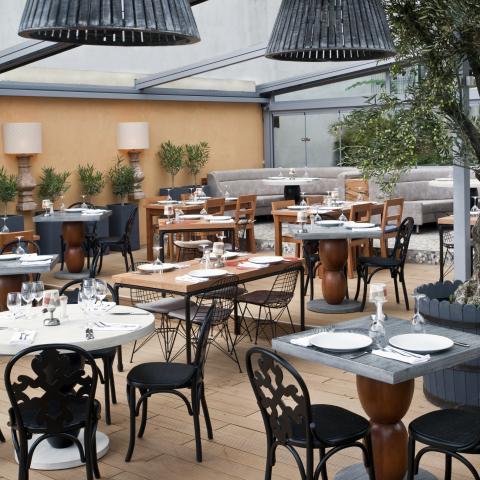
Where should you eat? Ask the locals!
B- Making a booking
Now you know where to go, but should you book a table? It depends. If you’re planning to dine with a large group, in a very popular restaurant, or during a particularly busy time for restaurants – such as äitienpäivä (“Mother’s Day”) – it’s a good idea to call or make an online booking. Otherwise, it should be fine to just turn up, though you may need to wait for a while for a table to become available. If you make a booking, be sure to turn up on time and always inform the restaurant if you need to cancel.
Here are phrases to help you make a phone booking in Finnish:
- Haluaisin varata pöydän kahdelle huomisillaksi. (”I’d like to book a table for two for tomorrow evening.”)
- Haluaisin tehdä pöytävarauksen kolmelle henkilölle sunnuntaiksi kello kuusi. (”I’d like to make a table booking for three on Sunday at six o’clock.”)
- Onko teillä lauantai-iltana tilaa kahdeksan hengen seurueelle? (”Do you have room for a group of eight on Saturday evening?”)
- Haluan peruuttaa pöytävarauksemme. Emme pääsekään tulemaan. (”I want to cancel our table booking. We can’t make it after all.”)
Now is also a good time to ask anything you need to know about the restaurant:
- Ovatko lapset tervetulleita? (”Are children welcome?”)
- Onko teillä lasten syöttötuolia / leikkipaikkaa? (”Do you have a high chair / play area for children?”)
- Onko ravintolanne esteetön pyörätuolin käyttäjille? (”Is your restaurant accessible for wheelchair users?”)
We will cover phrases about dietary requirements later on in the article!
C- Arrival
When you get to the restaurant, you may be asked if you have a reservation:
- Onko teillä pöytävaraus? (”Do you have a table reservation?”)
- Millä nimellä teillä on varaus? (”What name do you have a reservation under?”)
- Meillä on pöytävaraus nimellä Pekkala. (”We have a table booking under the name Pekkala.”)
- Olen varannut pöydän nimellä Karhu. (”I’ve booked a table under the name Karhu.”)
If you haven’t got a booking, you usually wait to be taken to a table, especially when you see a sign with this message:
- Olkaa hyvä ja odottakaa pöytiinohjausta. (“Please wait to be seated.”)
You will soon find out if there’s room:
- Tervetuloa! Seuratkaa minua. (“Welcome! Follow me.”)
- Valitettavasti meillä on täyttä. Voitteko tulla takaisin puolen tunnin päästä / puoli kahdeksalta? (”Unfortunately we’re full. Can you come back in half an hour / at half past seven?
- Kyllä, se sopii. (“Yes, that’s fine.”)
- Koetamme onneamme muualla, kiitos. (“We’ll try our luck elsewhere, thank you.”)
D- Your table
If there’s plenty of space in the restaurant (or you’re making a booking ahead of time), you may be able to choose where to sit. Here you’ll find phrases to help you talk about table preferences.
- Missä haluaisitte istua? (“Where would you like to sit?”)
- Haluatteko istua sisällä vai ulkona? (”Do you want to sit inside or outside?”)
- Haluamme istua ikkunapaikalla / terassilla / leikkipaikan vieressä / lähellä baaria. (”We want to sit by the window / on the terrace / next to the play area / near the bar.”)
- Voisimmeko saada isomman pöydän? (”Could we have a larger table?”)
- Voimmeko istua tuossa pöydässä? (”Can we sit at that table?”)
- Onko teillä pöytää hiljaisemmassa paikassa? (”Do you have a table in a quieter spot?”)
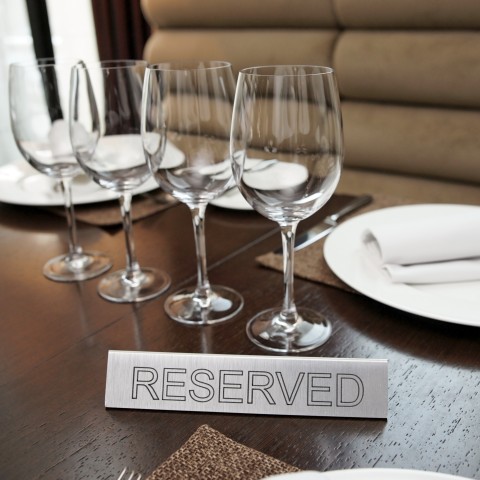
Pöytä on varattu. (”The table is reserved.”)
2. During Dining
Before we move on to ordering food, let’s cover some essential vocabulary. These phrases are super useful, so be sure to memorize them:
- Anteeksi. (“Excuse me”, “Sorry”)
- Kiitos. (”Thank you”, ”Please”)
- Kyllä kiitos. (”Yes please.”)
- Ei kiitos. (”No thank you.”)
- Haluaisin… (“I would like…”)
- En halua… (“I don’t want…”)
A- The Menu
Now onto the most delicious part – the food! Once you’re seated, it’s very likely that your waiter will hand you the menu, but we’ll teach you how to ask for one just in case. We’ll also cover various questions you may have about the food.
- Saisimmeko nähdä ruokalistan? (”Could we see the menu?”)
- Onko teillä ruokalistaa englanniksi? (”Do you have the menu in English?”)
- Onko teillä lasten ruokalistaa? (“Do you have a children’s menu?”)
- Kyllä, tuon sen teille heti. (”Yes, I’ll bring it to you right away.”)
- Valitettavasti ei ole. (“Unfortunately we don’t.”)
- Mikä on suosituin annoksenne? (”What’s your most popular dish?”)
- Mikä on päivän erikoinen? (“What’s today’s special?”)
- Mitä karjalanpaisti sisältää? (“What’s in the Karelian stew?”)
- Naudanlihaa, porsaanlihaa, sipulia ja juureksia. (”Beef, pork, onion and root vegetables.”)
- Do you want to quickly translate foods from English to Finnish? Find dishes, ingredients, and other food vocabulary in our handy online dictionary, and listen to how they are pronounced in Finnish!
Be sure to mention any preferences, dislikes, allergies and dietary requirements when ordering.
- Haluaisin syödä kevyen / täyttävän lounaan. Mitä suosittelette? (”I’d like to eat a light / filling lunch. What do you recommend?”)
- En pidä mausteisesta ruoasta. Sopiiko tämä annos minulle? (”I don’t like spicy food. Is this a good dish for me?”)
- Onko tässä annoksessa äyriäisiä? (”Does this dish contain shellfish?”)
- Olen allerginen pähkinöille. Voiko pähkinät jättää pois salaatista? (“I’m allergic to nuts. Can the salad be served without nuts?”)
- Vältän gluteiinia. Onko teillä gluteiinitonta pastaa / pitsaa? (”I avoid gluten. Do you have gluten free pasta / pizza?”)
- Voitteko valmistaa tämän ilman maitoa / kermaa? Minulla on laktoosi-intoleranssi. (”Can you prepare this without milk / cream? I am lactose intolerant.”)
- En syö eläintuotteita. Mitkä annokset ovat vegaanisia / voi valmistaa vegaanisena? (”I don’t eat animal products. Which dishes are vegan / can be made vegan?”)
- Onko ruokalistallanne jotain diabeetikolle sopivaa? (”Do you have something suitable for a diabetic on your menu?”)
These are some of the common allergens to look out for:
- maito (”milk”)
- muna (”egg”)
- pähkinä (”nut”)
- maapähkinä (”peanut”)
- soija (”soy”)
- vehnä (”wheat”)
- kala (”fish”)
- äyriäinen (”shellfish”)
- seesami (”sesame”)
B- Ordering Food and Drinks
Let’s order, starting with the food:
- Oletteko valmiit tilaamaan? (”Are you ready to order?”)
- Olemme valmiit tilaamaan. (”We’re ready to order.”)
- Tarvitsemme lisää aikaa. (”We need more time.”)
- Haluatteko tilata alkupaloja / lisukkeita? (“Do you want to order appetizers / side dishes?”)
- Ei tällä kertaa, kiitos. (”Not this time, thank you.”)
- Kyllä, otan leipää / salaattia / ranskalaisia perunoita / enemmän riisiä. (”Yes, I’ll have bread / salad / French fries / more rice.”)
- Mitä saisi olla? (”What would you like?”)
- Mitä haluaisitte alkuruoaksi / pääruoaksi? (“What would you like as the starter / the main course?”)
- Alkupalaksi otan päivän keiton ja pääruoaksi risoton. (”I’ll have the soup of the day as a starter and the risotto as the main course.”)
- Tilaan vain pääruoan. Haluaisin pihvin lohkoperunoilla. (”I’ll order just a main course. I’d like the steak with potato wedges.”)
- Entä teille? (”And for you?”)
- Otan tämän, kiitos. (”I’ll have this, please.”)
Next, let’s find out how to order drinks:
- Haluatteko tilata jotakin juotavaa? / Saisiko olla jotakin juotavaa? (”Would you like to order something to drink?”)
- Ehkä myöhemmin. (“Maybe later.”)
- Entä juotavaksi? (”And to drink?”)
- Haluaisimme nähdä viinilistan. (”We’d like to see the wine list.”)
- Mitä viiniä suosittelette? (”Which wine would you recommend?”)
- Lasi / pullo talon punaviiniä / valkoviiniä, kiitos. (”A glass / bottle of the house red wine / white wine, please.”)
- Otan appelsiinimehua / kivennäisvettä / olutta. (”I’ll have orange juice / mineral water / beer.”)
- Saisimmeko kannun/kannullisen vettä? (“Can we have a jug of water?”)
- Haluamme tilata lisää juomia. (“We want to order more drinks.”)
- What if you want to order cider? Learn more Finnish vocabulary by visiting Twenty Drinks to Quench Your Thirst vocabulary list.
Let’s hope you left some space for the dessert! Here’s how to order a sweet treat to finish the meal – or do as many Finns do and go for a cup of coffee:
- Haluatteko nähdä jälkiruokalistan? (“Would you like to see the dessert menu?”)
- Ei kiitos, otan vain kahvia. (”No thank you, I’ll just have a coffee.”)
- Ei kiitos, olen täynnä. (”No thank you, I’m full.”)
- Kyllä kiitos. (“Yes please.”)
- Haluaisimme tilata jälkiruokaa. (”We’d like to order dessert.”)
- Otan vaniljajäätelön suklaakastikkeella. (”I’ll have the vanilla ice cream with chocolate sauce.”)
- Haluaisin palan juustokakkua. (”I’d like a slice of cheesecake.”)
- Learn more useful phrases and listen to their correct pronunciation by visiting the Useful Phrases for Ordering Food free vocabulary list.

Lasten kanssa syömässä (”Dining with children”)
C- Other requests
Often, a waiter will check in during your meal and ask if everything is going well:
- Onko kaikki hyvin? (”Is everything alright?”)
If you need to get the attention of your waiter, you can simply say Anteeksi (“Excuse me”) followed by your request.
- Saisimmeko lisää vettä / leipää / lautasliinoja / jäitä? (“Could we have more water / bread / napkins / ice?”)
- Haluaisin toisen lasillisen viiniä / olutta, kiitos. (”I’d like another glass of wine / beer, please.”)
- Meiltä puuttuu suola ja pippuri. (”We haven’t got salt and pepper.”)
- Saisinko uuden lautasen / lasin / lusikan / haarukan / veitsen? Tämä on likainen. (”Could I have a new plate / glass / spoon / fork / knife? This one is dirty.”)
- Missä vessat ovat? (”Where are the toilets?”)
- Missä on naisten / miesten / esteetön vessa? (”Where is the women’s / men’s / accessible toilet?”)
- Missä voin vaihtaa vauvan vaipan? (”Where can I change the baby’s diaper?”)
- Learn what a wine glass is called in Finnish in the Food Utensils and Tableware vocabulary list.
D- Feedback and problems
Your waiter may also ask you if you’re enjoying the food:
- Miltä ruoka maistuu? (”How is the meal?”)
- Ruoka on herkullista. (”The food is delicious.”)
- Tämä on todella hyvää. (“This is really good.”)
If there are any issues, let the staff know as soon as possible to give them a chance to put things right:
- Olen pahoillani, mutta… (”I’m sorry, but…”)
- En tilannut tätä. (“I didn’t order this.”)
- Keitto on kylmää. (“The soup is cold.”)
- Tämä on liian suolaista. (”This is too salty.”)
- Tämä maistuu raa’alta / palaneelta. (”This tastes raw / burned.”)
- Pyysin jättämään kerman pois. (“I asked to leave the cream out.”)

Hymyilevä tarjoilija (”A smiling waiter”)
3. After Dining
The only thing left to do after a satisfying meal is to settle the bill. This section will help you successfully navigate the payment process in Finnish.
A- The Bill
When you’re ready to pay, you can ask for the bill using one of these phrases:
- Lasku, kiitos. (”The bill, please.”)
- Saisimmeko laskun? (“Could we have the bill?”)
- Olemme valmiita maksamaan. (“We’re ready to pay.”)
If you notice a mistake, mention it right away:
- Anteeksi, laskussa on virhe. (”Sorry, there’s a mistake in the bill.”)
- Anteeksi, laskussa taitaa olla virhe. (“Excuse me, I think there’s a mistake in the bill.”)
Who’s paying? Here’s how to communicate whether you’re paying together or separately:
- Haluatteko maksaa erikseen vai yhdessä? (”Do you want to pay separately or together?”)
- Haluaisimme maksaa erikseen. (”We would like to pay separately.”)
- Maksamme yhdessä. (“We’ll pay together.”)
- Minä tarjoan. (“It’s on me.”)
B- Payment methods
Cash, card, or something else? Let’s talk about payment methods:
- Miten haluaisitte maksaa? (”How would you like to pay?”)
- Maksamme käteisellä. (”We’ll pay with cash.”)
- Haluan maksaa pankkikortilla / luottokortilla. (”I want to pay with a debit card / credit card.”)
- Mitkä luottokortit hyväksytte? (”Which credit cards do you accept?”)
- Voinko tehdä mobiilimaksun / lähimaksun? (”Can I make a mobile payment / a contactless payment?”)
- Note that contactless payment works only for transactions up to 50 euros.
- Find out which mobile payments are popular in Finland.
C- Tipping
Should you leave a tip in Finland? In short: it’s not compulsory or expected, but it is appreciated. There are Finns who tip habitually and Finns who never do. Many Finns will leave a tip when the service and food have been exceptional. Note that tips are often divided equally among all restaurant staff and are taxed like regular income in Finland.
There are no strict rules when it comes to the size of the tip, but anything between 5% and 15% of the bill is acceptable. Some people simply ask the waiter to ‘round up’ their bill or keep the change when they’re paying. If you have cash on hand, you can leave the tip on the table before you leave. If you’re paying by card, you may have the option to add a tip using the payment terminal – or simply ask your waiter to add a tip to the bill.
- Voitte pitää vaihtorahan. (“You can keep the change.”)
- Voitte lisätä viisi euroa tippiä. (”You can add five euros as a tip.”)
- Voitte pyöristää kuuteenkymmeneen euroon. (”You can round up to sixty euros.”)
- Haluaisin jättää tipin. Miten se onnistuu? (”I’d like to leave a tip. How do I do it?”)
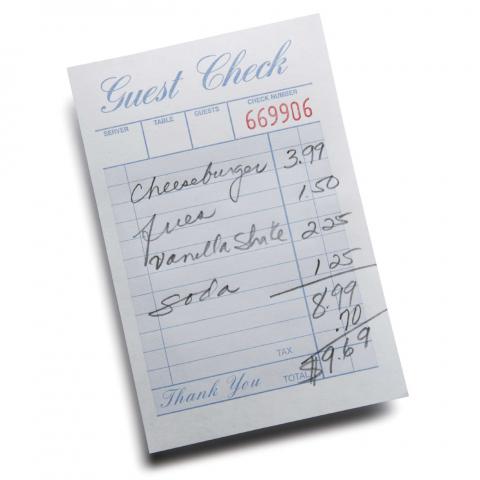
Lasku, kiitos. (“The bill, please.”)
- If you’d like to see more examples of restaurant phrases and listen to recordings to help you with your pronunciation, our Finnish restaurant vocabulary and phrases list is for you.
- Do you have time for another quick Finnish language lesson? To learn food phrases in Finnish, try our vocab builder, Food.
4. How FinnishPod101 Can Help You Learn More Finnish
In this guide, we have covered the entire dining experience, from asking for restaurant recommendations and booking a table to ordering food and making a payment. Do you know any other Finnish restaurant words and phrases that we should have included? Feel free to drop a comment to give us feedback, or let us know what other guides you’d like to see on the FinnishPod101 blog!
Be sure to stop by FinnishPod101 and explore everything we have to offer. We provide plenty of free resources, including a large collection of vocabulary lists. We also have an extensive lesson library and a premium service, MyTeacher, for learners who want to supercharge their studies with 1-on-1 coaching and a personalized study plan.
Happy learning on FinnishPod101!

Top Finnish Animal Names and Phrases

Let’s talk about Finland’s animals! In this article, we’ll teach you important Finnish animal vocabulary as well as some idiomatic animal-related terms and expressions. You’ll even find a few interesting facts about Finland’s fauna in this guide.
Tip: If you know what your preferred learning style is, you can play to your strengths and make memorizing new vocabulary a little easier. For example, if you’re primarily a visual learner, try creating your own thematic mini dictionary with pictures or watch Finnish vocabulary videos on the FinnishPod101 YouTube channel. Or, if you’re a kinesthetic learner and learn best through movement, why not challenge your friends or family to a game of charades in Finnish?
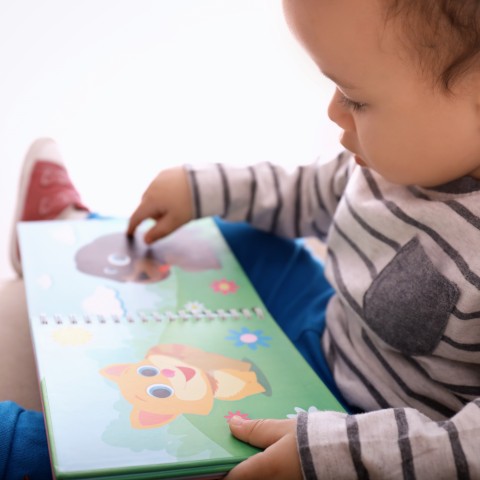
Learning Finnish animal names is child’s play.
 Table of Contents
Table of Contents
- At Home
- On the Farm
- In the Forest
- In the Lakes, Rivers, and the Sea
- Bugs and Insects
- Birds, Reptiles, and Amphibians
- Animal Body Parts
- Animal-Related Terms and Expressions
- Lopuksi
1. At Home
Let’s kick things off by learning the Finnish words for popular pets! Roughly a third of Finnish households have a pet (lemmikkieläin), with dogs and cats being the most popular pets by far. Do you keep one (or more) of the following animals as a pet?
- koira (“dog”)
- kissa (“cat”)
- hamsteri (“hamster”)
- marsu (“guinea pig”)
- kani (“bunny”)
- rotta (“rat”)
- kultakala (“goldfish”)
- kilpikonna (“tortoise”)
- undulaatti (“budgie”)
- papukaija (“parrot”)

Suositut lemmikkieläimet (“Popular pets”)
- When learning new words, it’s a good idea to listen to how a native speaker pronounces them. You’ll find recordings on all of our vocabulary lists, including this one on animal names.
2. On the Farm
Next up: the names of common farm animals in Finnish!
- lehmä (“cow”)
- sika (“pig”)
- hevonen (“horse”)
- lammas (“sheep”)
- vuohi (“goat”)
- kana (“chicken”)
- kukko (“rooster”)
- ankka (“duck”)
- hanhi (“goose”)
- poro (“reindeer,” a semi-domesticated animal that’s an integral part of the Sámi culture in Finnish Lapland)

Lehmä laitumella (“A cow in a pasture”)
- Do you remember the song Old MacDonald Had a Farm from your childhood? In Finnish, the song is known as Piippolan vaarilla oli talo (“Grandpa Piippola Had a House”).
- We have a lesson just about farm animals to help you master this useful vocabulary set.
3. In the Forest
Finland’s forests are home to many wild animals, including a few large carnivores. Here’s what to call some of these animals in the Finnish language:
- karhu (“bear”)
- susi (“wolf”)
- kettu (“fox”)
- hirvi (“moose”)
- jänis (“rabbit”)
- orava (“squirrel”)
- ahma (“wolverine”)
- ilves (“lynx”)
- kärppä (“weasel”)
- mäyrä (“badger”)
- näätä (“marten”)
- supikoira (“raccoon dog”)
- hiiri (“mouse”)
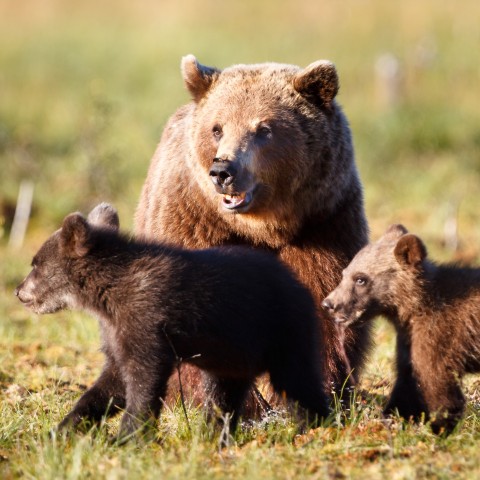
Karhuemo pentuineen (“A mother bear with her cubs”)
- The brown bear is one of Finland’s national symbols. The animal was a central figure in the mythology of ancient Finns, and there are over 200 words for “bear” in Finnish, including mesikämmen, kontio, otso, and tapio.
4. In the Lakes, Rivers, and the Sea
Finland has a coastline as well as plenty of freshwater habitats. You’ll find both fully aquatic and semiaquatic animals on this list.
- kala (“fish”)
- lohi (“salmon”)
- ankerias (“eel”)
- simpukka (“clam”)
- meduusa (“jellyfish”)
- jokirapu (“crayfish”)
- valas (“whale”)
- hylje (“seal”)
- majava (“beaver”)
- saukko (“otter”)

Hylje elää maalla ja vedessä. (“A seal lives on land and in the water.”)
- Pyöriäinen (“porpoise”) is the only type of whale regularly encountered in Finnish waters. Two types of seals are found in Finland: halli or harmaahylje (“gray seal”) and saimaannorppa (“Saimaa ringed seal”). The Saimaa ringed seal is only found in Lake Saimaa in Finland and is one of the most endangered seals in the world.
- The shark and the octopus may not be native to Finland, but you can learn the Finnish words for these (and other) animals on our Marine Animals & Fish vocabulary list.
5. Bugs and Insects
Beautiful, gross, scary—insects and other creepy-crawlies elicit strong feelings in many people! Let’s learn the Finnish words for some of the most common little beasties, including Finland’s most infamous resident: the mosquito. (If you’re planning a trip to Finland in summer, you may want to come prepared!)
- hyttynen or itikka (“mosquito”)
- perhonen (“butterfly”)
- kärpänen (“fly”)
- mehiläinen (“bee”)
- ampiainen (“wasp”)
- muurahainen (“ant”)
- sudenkorento (“dragonfly”)
- leppäkerttu (“ladybug”)
- koppakuoriainen (“beetle”)
- hämähäkki (“spider”)
- mato (“worm”)
- etana (“snail”)

Leppäkerttu on hyönteinen. (“The ladybug is an insect.”)
6. Birds, Reptiles, and Amphibians
Interesting fact: Did you know that reptiles (matelijat) are more closely related to birds (linnut) than to amphibians (sammakkoeläimet)?
- joutsen (“swan”)
- pöllö (“owl”)
- varis (“crow”)
- harakka (“magpie”)
- kotka (“eagle”)
- lokki (“seagull”)
- käärme (“snake”)
- lisko (“lizard”)
- sammakko (“frog”)
- (rupi)konna (“toad”)
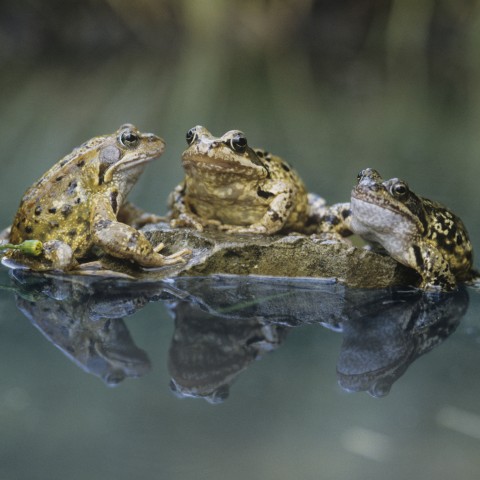
Kolme sammakkoa kivellä (“Three frogs on a rock”)
7. Animal Body Parts
In this section, we’ll go over the Finnish words for important animal body parts.
- tassu (“paw”)
- häntä (“tail”)
- kuono (“snout”)
- sarvi (“horn” / “antler”)
- turkki (“fur”)
- siipi (“wing”)
- nokka (“beak”)
- pyrstö (“tail,” of birds and fish)
- räpylä (“flipper”)
- evä (“fin”)
- lonkero (“tentacle”)
You now know a number of animal names in Finnish and what to call their body parts…but do you know the Finnish vocabulary for animal noises?

Joutsenella on kauniit siivet. (“The swan has beautiful wings.”)
8. Animal-Related Terms and Expressions
There are countless idiomatic animal-related terms and expressions in Finnish. If you’re up for a challenge, see if you can incorporate a couple of the following words or phrases into your next conversation in Finnish!
1 – Nouns
- harakanvarpaat (“chicken scratch” or “scrawl” / literally: “magpie’s toes”)
- koiranilma (“bad weather” / literally: “dog’s weather”)
- kissanristiäiset (“unimportant celebration” / literally: “cat’s christening”)
- villakoira (“dust bunny” / literally: “wool dog,” which also means “poodle”)
- karhunpalvelus (“disservice” / literally: “bear’s service”)
- uutisankka (“canard” / literally: “news duck”)
- sudennälkä (“ravenous hunger” / literally: “wolf’s hunger”)
- kissanpäivät (“the life of Riley” / literally: “cat’s days”)
- katin kontit (“nonsense” or “rubbish” / literally: “cat’s knapsacks,” an exclamation)
- teerenpeli (“flirtation” / literally: “grouse’s game”)
2 – People
- jänishousu (“scaredy-cat” or “chicken” / literally: “rabbit pants”)
- verokarhu (“taxman” / literally: “tax bear,” a playful term for verottaja)
- pahanilmanlintu (“bird of ill omen” / literally: “bad weather’s bird”)
- työmyyrä (“workhorse” / literally: “work vole”)
- koiranleuka (“joker” / literally: “dog’s jaw”)
- pullahiiri (“person with a sweet tooth” / literally: “bun mouse”)
- vastarannan kiiski (“contrarian” / literally: “ruffe of the opposite shore”)
- susipari (“unmarried, cohabiting couple” / literally: “wolf couple”)
- vilukissa (“person who feels cold easily” / literally: “chill cat”)
- koekaniini (“guinea pig” / literally: “test rabbit”)
- konttorirotta (“pen-pusher” / literally: “office rat”)
- linssilude (“lens hog” / literally: “lens bug”)
- vasikka (“informer” or “snitch” / literally: “calf”)
- pöllö (“fool” / literally: “owl,” derogatory)
3 – Idioms
- kiertää kuin kissa kuumaa puuroa (“to beat around the bush” / literally: “to circle like a cat around hot porridge”)
- nostaa kissa pöydälle (“to bring up a difficult subject” / literally: “to lift a cat onto the table”)
- seurata kuin hai laivaa (“to be hot on one’s heels” / literally: “to follow like a shark follows a ship”)
- olla koira haudattuna (“something fishy” / literally: “there’s a dog buried”)
- näyttää närhen munat (“to teach someone a lesson” / literally: “to show jay’s eggs”)
- olla oma lehmä ojassa (“to have a vested interest in something” / literally: “to have one’s own cow in a ditch”)
- tehdä kärpäsestä härkänen (“to make a mountain out of a molehill” / literally: “to make a bull out of a fly”)
- tappaa kaksi kärpästä yhdellä iskulla (“to kill two birds with one stone” / literally: “to kill two flies with one hit”)
- olla ketunhäntä kainalossa (“to have a hidden agenda” / literally: “to have a foxtail under the arm”)
- olla käärmeissään (“to be annoyed” / literally: “to be in one’s snakes”)
- olla kananlihalla (“to have goosebumps” / literally: “to be on chicken meat”)
4 – Verbs
- sikailla (“to behave badly” / from the word “pig”: sika)
- hamstrata (“to squirrel” or “to hoard” / from the word “hamster”: hamsteri)
- apinoida (“to ape” or “to mimic” / from the word “monkey”: apina)
- kukkoilla (“to strut one’s stuff” / from the word “rooster”: kukko)
- ahmia (“to wolf down” / from the word “wolverine”: ahma)
- jänistää (“to chicken out” / from the word “rabbit”: jänis)
- lokkeilla (“to freeload” / from the word “seagull”: lokki)
- hevostella (“to flaunt” or “to behave arrogantly” / from the word “horse”: hevonen)
5 – Similes
- pirteä kuin peipponen (“perky as a chaffinch”)
- terve kuin pukki (“healthy as a horse” / literally: “healthy as a billy goat”)
- lauhkea kuin lammas (“mild as a sheep”)
- märkä kuin uitettu koira (“wet as a dog immersed in water”)
- ahkera kuin mehiläinen (“industrious as a bee”)
- kiukkuinen kuin ampiainen (“mad as a hornet” / literally: “angry as a wasp”)
- puhdas kuin pulmunen (“clean as a whistle” / literally: “clean as a snow bunting”)
- köyhä kuin kirkonrotta (“poor as a church mouse” / literally: “poor as a church rat”)
- itsepäinen kuin muuli (“stubborn as a mule”)
- uskollinen kuin koira (“loyal as a dog”)
- lämmin kuin lehmän henkäys (“warm as cow’s breath,” used when talking about air temperature)
- kuin täi tervassa (“extremely slow” / literally: “like a louse in tar”)
One of the best ways to learn new vocabulary is to put the words into context. Our Finnish animal words video does exactly that!
9. Lopuksi
We hope that you found this guide to Finnish animal words to be the cat’s meow! What other types of vocabulary would you like to see covered on our blog? Let us know by leaving a comment below.
FinnishPod101 offers plenty of free resources to help you on your Finnish learning adventure, including an ever-growing library of vocabulary lists complete with recordings to help you perfect your pronunciation. We are constantly adding new learning material to suit all learning styles and confidence levels, so be sure to check back often.
Happy learning on FinnishPod101!

How to Say “I Love You,” in Finnish

We don’t choose who we fall in love with. Therefore, it’s entirely possible that one day, while you’re busy minding your own business, you’ll be swept off your feet by a charming Finn. Or perhaps this has already happened to you, and that’s how you discovered this guide? In any case, if you want to learn Finnish love phrases, you’ve come to the right place.
This article will teach you how to say “I love you,” in Finnish, as well as all the key phrases you’ll need at different stages of a romantic relationship—from asking a Finnish cutie out to planning your marriage proposal. We’ll also cover the most commonly used Finnish endearment terms and give you some cultural insights regarding love and romance in Finland.
By the way, if you’re already deeply in love with a Finn, you’ll be happy to know that falling in love can help you learn Finnish faster!
 Table of Contents
Table of Contents
- Confess Your Affection
- Fall in Deeper
- Take it One Step Further
- Endearment Terms
- Must-know Love Quotes
- Lopuksi

1. Confess Your Affection
Has a beautiful stranger caught your eye? Have you got a crush on a handsome acquaintance? In this section, you’ll learn how to let someone know that you’re interested in them. Note that we’ll use the casual sinä (informal “you”) rather than the polite te (formal and plural “you”) throughout this guide.
Finnish people aren’t quite as taciturn as the national stereotype would have you believe, but you can expect them to be more reserved than, say, your typical American or Italian. Don’t let that discourage you—just be honest and real (and prepared to carry the conversation for a bit) when you approach a Finn, and you’re likely to make a favorable first impression. And ladies: It’s considered fine for a woman to make the first move!
Here’s how to ask someone to join you on the dance floor, tell them that you like their smile, or ask them if they’re already taken:
- Haluaisitko tanssia kanssani? (“Would you like to dance with me?”)
- Voinko tarjota sinulle drinkin? (“Can I get you a drink?”)
- Sinulla on kaunis hymy / kauniit silmät. (“You have a beautiful smile / beautiful eyes.”)
- Olet todella mukava / kaunis / komea. (“You’re really nice / beautiful / handsome.”)
- Onko sinulla poikaystävää / tyttöystävää? (“Do you have a boyfriend / a girlfriend?”)
- Oletko sinkku / varattu? (“Are you single / taken?”)
How did it go? If you’ve been having a good time together, go ahead and tell them that you’d like to see them again:
- Olisi kiva nähdä sinut uudestaan. (“It would be nice to see you again.”)
- Haluaisin viettää enemmän aikaa kanssasi. (“I’d like to spend more time with you.”)
- Haluaisin tutustua sinuun paremmin. (“I’d like to get to know you better.”)
- Vaihdetaanko numeroita? (“Shall we exchange numbers?”)
- Voinko soittaa sinulle? (“Can I call you?”)
- Oletko vapaa huomenna? (“Are you free tomorrow?”)
- Lähtisitkö joskus kanssani syömään / kahville / kävelylle? (“Would you like to go out for a meal / a coffee / a walk with me sometime?”)
Finally, to ensure that you and your love interest are on the same page, here are a few Finnish dating verbs defined:
- Käydä treffeillä (“to go on dates”)
- Tapailla (“to see each other casually”)
- Seurustella (“to be in a relationship,” or literally “to socialize” / “to date”)
Be thoroughly prepared for that all-important first date by learning the Most Common Phrases You’ll Need for a Date and the 10 Most Romantic Ideas for a Date in Finnish.

Vaihdetaanko numeroita? (“Shall we exchange numbers?”)
2. Fall in Deeper
Have you got butterflies in your belly when you think of that special someone? Perhaps you’re falling in love… Before you go and confess your feelings, it’s good to know that the Finnish word for “love”—rakkaus—is not used lightly. Just look at that strong rolled ‘r’ at the beginning, that terse double ‘k’ in the middle, and that sibilant ‘s’ at the end…it makes sense that such a powerful word is used only when it’s really meant!
With that in mind, let’s first look at alternatives to saying “I love you.”
- Pidän sinusta todella paljon. (“I like you a lot.”)
- Olen ihastunut sinuun. (“I have a crush on you.”)
- Olen hulluna sinuun. (“I’m crazy about you.”)
- Minulla on ikävä sinua. (“I miss you.”)
- En voi olla ajattelematta sinua. (“I can’t stop thinking about you.”)
If things get more serious and you’re ready to declare your love, there are a few different ways to say “I love you,” in Finnish (and to ask if they love you, too).
- Minä rakastan sinua. (“I love you.”)
- Minä rakastan sinua myös. (“I love you too.”)
- Rakastatko sinä minua? (“Do you love me?”)
- Olen rakastunut sinuun. (“I’ve fallen in love with you.”)
- Rakastan sinua koko sydämestäni. (“I love you with all my heart.”)
To keep things interesting, here are some alternative ways to express your love in Finnish:
- Teet minut onnelliseksi. (“You make me happy.”)
- En voisi elää ilman sinua. (“I could not live without you.”)
- Olet todella tärkeä minulle. (“You are really important to me.”)
Did you know that the Finnish ystävänpäivä (“Valentine’s Day,” or literally “friend’s day”) is primarily a celebration of friendship? Discover more about how Valentine’s Day is celebrated in Finland on our YouTube channel in the video below (and learn 15 Finnish Love Phrases for Valentine’s Day while you’re at it).

Rakastatko sinä minua? (“Do you love me?”)
3. Take it One Step Further
If things are going really well with your Finnish sweetheart and you’re ready to take the next step in your relationship, this section is for you.
Let’s start with some key vocabulary:
- Asua yhdessä (“To live together”)
- Avopuoliso (“Live-in partner”)
- Kosia (“To propose”)
- Mennä kihloihin (“To get engaged”)
- Mennä naimisiin (“To get married”)
- Vaimo (“Wife”)
- Aviomies (“Husband”)
- Aviopuoliso (“Spouse”)
- Perustaa perhe (“Start a family”)
Do you want to tell someone that you’d like them to meet your parents, or to suggest moving in together? Here’s what you can say:
- Haluaisin esitellä sinut vanhemmilleni. (“I’d like to introduce you to my parents.”)
- Haluatko tavata vanhempani? (“Do you want to meet my parents?”)
- Haluan muuttaa yhteen kanssasi. (“I want to move in with you.”)
- Muutetaan yhteen. (“Let’s move in together.”)
Are you ready to make the ultimate commitment and get married? In Finland, it’s more common for a man to propose to a woman than vice-versa. That said, if you’re a woman, you might want to pop the question on a leap day—according to a Finnish tradition, if a man rejects your proposal on a leap day, he’s obliged to buy you enough fabric for a skirt as compensation! Those in a same-sex relationship also have the option to get married if they wish, as Finland legalized same-sex marriage in 2017.
Here are a few different ways to propose:
- Tuletko vaimokseni / aviomiehekseni / aviopuolisokseni? (“Will you marry me?” Literally: “Will you be my wife / husband / spouse?”)
- Suotko minulle kunnian tulla vaimokseni / aviomiehekseni / aviopuolisokseni? (“Will you give me the honor of becoming my wife / husband / spouse?”)
- Mennäänkö naimisiin? (“Shall we get married?”)
- Vietetään loppuelämämme yhdessä. (“Let’s spend the rest of our lives together.”)
Visit FinnishPod101.com for even more Finnish Marriage Proposal Lines.
Many people in Finland start a family before they get married, and some couples with children never make their relationship official. Whatever you and your partner decide to do, here are two ways to express your desire to have children together:
- Haluaisin hankkia lapsia kanssasi. (“I’d like to have children with you.”)
- Perustetaan perhe yhdessä. (“Let’s start a family together.”)
What if things aren’t going well and you want to part ways? Bite the bullet and let them know with one of these common Finnish break-up lines.

Tuletko vaimokseni? (“Will you be my wife?”)
4. Endearment Terms
The Finnish word for “endearment term” or “pet name” is hellittelynimi, which is derived from the words hellitellä (“to care for” / “to fuss over” / “to fondle”) and nimi (“name”). If you’re looking for the perfect Finnish pet name for your beloved, you’ll find both serious and silly ones to pick from in this section. Which of these sweet love words in Finnish do you like the most?
- Rakas (“Dear” / “Beloved”)
- Rakkaani (“My dear” / “My beloved”)
- Kulta (“Gold”)
- Muru (“Crumb”)
- Höpönassu (“Silly face”)
- Höppänä (“Silly”)
- Söpöliini (“Cutie”)
- Possunen (“Piggy”)
- Pupu (“Bunny”)
- Aarre (“Treasure”)
- Sydänkäpy (“Sweetheart” / Literally: “Heart pinecone”)
It’s also common to create pet names by adding certain endings to your beloved’s name. The possibilities are endless! For example:
- Tommi + -liini = Tommiliini
- Tessa + -kka = Tessukka
To discover more Finnish endearment terms and ways to create new ones, check out this article (in Finnish) on Ilta-Sanomat.

Oma pikku höpönassuni. (“My little silly face.”)
5. Must-know Love Quotes
Now that you’ve learned lots of useful love sentences in Finnish to help you navigate the key moments of your own love story, let’s see what Finnish proverbs and famous quotes say about romantic love.
1. Finnish Love Proverbs
- Nauru nuorentaa, rakkaus kaunistaa. (“Laughter makes one younger, love makes one prettier.”)
- Rakkaus on kuin sipuli: mitä pitemmälle kuorit, sitä enemmän itket. (“Love is like an onion, the further you peel, the more you cry.”)
- Yskää ja rakkautta ei voi salata. (“One can’t hide a cough or love.”)
2. Finnish Love Quotes
- “Minä en äiteliä puheita suvaitse. Rakkaus on tekemistä. Rakkaus on sitä, että pitää sanansa ja tulee ajallaan syömään.” (“I cannot abide sappy talk. Love is doing. Love is keeping your word and coming to eat on time.”)
Arja Tiainen, author
- “Rakkauden salaisuus on sama kuin uskonnon: molemmat ovat yhtä käsittämättömiä ulkopuolella oleville.” (“The secret of love is the same as that of religion: both are equally incomprehensible to those on the outside.”)
Aino Kallas, author
- “Miten paljon rakastettuasi rakastat, tiedät vasta, kun olet hänet menettänyt.” (“You will know how much you love your beloved only when you have lost them.”)
Maria Jotuni, author
Do you agree with any of these statements? If you’re looking for more Finnish Quotes about Love, FinnishPod101 has got you covered.

6. Lopuksi
In this guide, you’ve learned how to say “I love you,” in Finnish. We’ve also explored how to flirt, how to ask someone out, and even how to propose marriage in Finnish. Do you know any other useful Finnish love phrases or cute endearment terms that we didn’t include? Leave a comment below and share them with the community!
If romance and love have gotten you interested in learning Finnish, we invite you to explore everything that FinnishPod101 has to offer. Why not get started with our free resources or learn how to pronounce words with our handy Finnish vocabulary lists? Remember that we also have a YouTube channel, a mobile app, and a Premium PLUS program that provides expert 1-on-1 tutoring to help you succeed in your studies.
Until next time, happy learning and good luck!

Why study Finnish? 10 reasons to start learning today.

Why learn Finnish? Are there any benefits to studying Finnish beyond that lovely sense of accomplishment you get when you master a new skill? There definitely are, and we’re going to discuss no fewer than 10 reasons to start learning Finnish.
To mention just a few, learning Finnish will expose you to a different way of seeing the world, provide opportunities to develop yourself, and open many doors—it might even help keep your brain healthy and make you happier!
Intrigued? Read on to discover even more perks of learning Finnish and whether studying it could be for you.

Will you fall in love with the Finnish language?
 Table of Contents
Table of Contents
- Gain insights into a fascinating culture.
- Connect and communicate with Finnish people.
- Enjoy Finnish entertainment on a whole new level!
- Have more fun traveling in Finland.
- Live in the happiest country in the world.
- Get a world-class education in Finland.
- Build a successful career in Finland.
- Give your brain a good workout.
- Have a giggle learning funny words and phrases.
- Get in on a secret: Finnish is easier to learn than you think.
- Lopuksi
1. Gain insights into a fascinating culture.
“To have another language is to possess another soul.“
This quote is attributed to Charlemagne—and he may have been on to something. Learning a new language can open our eyes to help us see the world from a different perspective and expose us to new ways of thinking. Language is also the gateway into the heart of a culture, and if you’re fascinated by the land of sauna, sisu, and salmiakki (“salmiak liquorice”), learning Finnish is the most effective and rewarding way to truly understand this unique northern country.
For example, to learn Finnish is to appreciate snow in a whole new way. Finns have come up with quite a few specific terms for different types of snow. There’s the snow that you can mold into a snowman or snowballs (nuoska), the snow that clings to trees (tykky), the snow that covers the ground in a thick layer (hanki), and the snow that whips you in the face when it’s windy outside (tuisku). These are just a few examples, but curiously there is no Finnish term for “to snow.” Finns say sataa lunta (“to rain snow”) instead.
- Did we make you dream of snowy days? Learn some Finnish vocabulary related to winter with FinnishPod101.
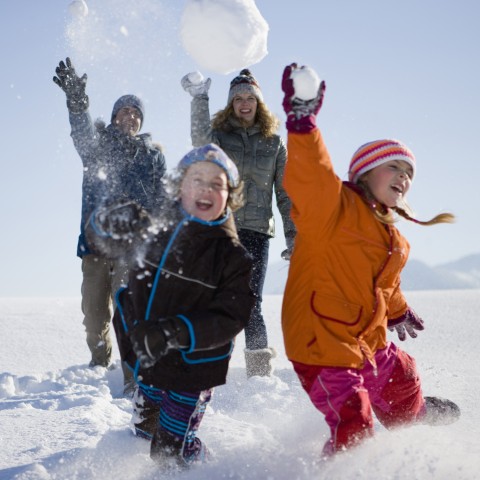
2. Connect and communicate with Finnish people.
This is one of the more obvious reasons why you should learn Finnish, but if you have Finnish-speaking family, friends, colleagues, or business partners, learning Finnish can improve your communication with them dramatically. This is true even if you’re interacting with Finns who speak excellent English, because—as we’ve already seen—learning a language makes it easier to understand different perspectives.
But what if you don’t know any Finnish people? Then maybe it’s time to remedy this situation and get to know a few! There’s no better ice-breaker than speaking a bit of Finnish when you meet a Finn, whether in Finland or elsewhere.
3. Enjoy Finnish entertainment on a whole new level!
Whether you’re into music, cinema, TV, or books, Finland has a lot to offer.
Fans of heavy metal and hard rock know Finland for its music scene, which has produced numerous notable bands, from Ajattara to Stam1na. (Did you know that there’s even a heavy metal band—Hevisaurus—that’s specifically geared toward children?!) Nordic Noir aficionados will likewise be well-aware of Finland’s contributions to the genre, including the nail-biting TV series Deadwind and Bordertown as well as crime fiction penned by Antti Tuomainen and Kati Hiekkapelto. Film buffs may already have seen a number of Finnish films, such as Rare Exports and The Man Without a Past.
While it’s entirely possible to rely on subtitles when you watch a film, listen to music without understanding the lyrics, and wait for an English translation to hit the market before reading a book, you’re bound to get a lot more out of Finnish entertainment when you learn some Finnish. Incidentally, reading, watching, or listening to something in Finnish is also an excellent way to speed up your language learning!
- To start, why not learn some Finnish vocabulary for Talking About Books and Going to the Movies?
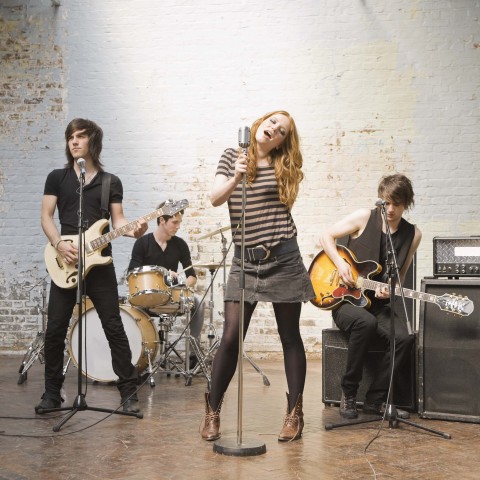
Understanding the lyrics makes listening to music more meaningful.
4. Have more fun traveling in Finland.
Are you thinking of visiting Finland? If you are, learning some Finnish will make your trip easier, more immersive, and more rewarding. Finding your way around will be much simpler when you can read Finnish on signs and maps, decipher timetables, and ask people for directions. Likewise, you can feel more confident when ordering food, making reservations, and shopping for souvenirs.
Of course, interacting with locals is one of the most fun parts of traveling, and Finns will find it delightful if you speak even a little bit of Finnish. Knowing some Finnish will also help you navigate situations like going to a sauna for the first time. For example, if someone says Lisää löylyä! (“More steam!”), you’ll know that it’s your cue to get out quickly if you’re not ready to get any warmer!

5. Live in the happiest country in the world.
Have you ever considered living abroad? Then you could do a lot worse than choose Finland: In 2020, Finland was ranked the happiest country for the third consecutive year. What exactly makes Finland such a happy place? It could have something to do with the following:
Safety
According to the Global Peace Index, Finland is ranked the 14th safest country in the world. Things that make Finland a safe place include low levels of organized crime, high political stability, and a lack of natural disasters.
Tolerance
Finland is also ranked the 2nd most liberal country in the world. Freedom of speech, freedom of religion, and equality are all important Finnish values.
Healthy Environment
Finland excels in the Environmental Performance Index as well: The country is ranked the 7th most environmentally friendly country in the world, while air quality and drinking water quality in Finland are the best in the world.
Are you ready to pack your bags and settle in Finland? In order to get a Finnish citizenship, you’ll need to get your hands on a National Certificate of Language Proficiency (YKI). And of course, you’ll find life in Finland much easier if you can speak Finnish.
- Feeling as happy as a Finn? Express your joy by learning the Top 20 Words for Positive Emotions in Finnish.

Feeling happy
6. Get a world-class education in Finland.
Perhaps you’re not quite ready to move to Finland permanently, but would like to experience living in the country nonetheless. In that case, studying in Finland could be for you!
Finland is a fantastic place for students, featuring one of the best higher education systems in the world and nine universities ranked among the top 3% in the world.
Other perks of studying in Finland include:
English-taught Degrees
Finland offers over 400 English-taught bachelor’s and master’s programs as well as doctoral degree options.
Tuition Fees
If you’re a European Union (EU) or European Economic Area (EEA) citizen, studying in Finland is free for you! For other international students, course fees range between 5,000 and 18,000 euros per year, but most universities offer scholarships that help cover the fees.
Cost of Living
As a student in Finland, you’ll have access to affordable student housing, cheap meals on campus, and a plethora of generous student discounts, including significantly cheaper travel on public transport across the country.
Career Services
Most Finnish universities offer help with job searching and career planning to international students. A student visa allows one to work part-time and a one-year post-study visa allows graduates to stay in Finland while searching for a job.
Now you may be asking: “Why should I learn Finnish if I can study in English in Finland?” Well, you’ll have access to a wider range of courses if you know Finnish, and it will no doubt look good on your application form. And of course, you’ll also have an easier time throwing yourself into the fun aspects of student life, such as participating in extracurricular activities and making new friends.
- Prepare for student life in Finland by picking up some Essential Vocabulary for Talking About Education. Or if you’re a bad student, check out our Too Cool for School Finnish vocabulary list!

Studying in Finland could be the best experience of your life.
7. Build a successful career in Finland.
Are your student days already behind you? Then working in Finland might appeal to you more. Here are just a few reasons to build a career in Finland:
High Demand for International Labor
Many sectors in Finland are in need of more workers, and international recruits are in high demand in the healthcare and service sectors, for example. Visit the Occupational Barometer to see if your skills are currently sought after in Finland.
Support for Immigrants
New employees from abroad can often access support with integration. Language training is also usually offered by local authorities and/or employers, either for free or at a low cost.
Great Working Conditions
In Finland, employment security is high, and both equality and cooperation at the workplace are considered important. Employers also tend to invest in their employees, and further training and skill development are encouraged.
So what is the best way to secure a job in Finland? To learn Finnish! Almost all jobs in Finland require at least some knowledge of Finnish. However, once you’ve learned Finnish, your native language could be a great asset too, depending on the position!
Remember too that Finland is home to many internationally successful companies, such as Nokia, KONE, and Supercell, and learning Finnish could well give you an advantage in making connections and building business relationships with Finnish companies in your own country as well.
- What’s your dream job? Learn the vocabulary for some of the most popular jobs in Finnish.

Get ahead in your career.
8. Give your brain a good workout.
Want to keep your brain healthy? Then put away that brain training app and learn Finnish instead. Why? Because learning a new language is to your brain what lifting weights is to your muscles. Activities like wrestling with grammar and memorizing vocabulary activate various parts of your brain, and they’re a fantastic way to improve and preserve your cognitive skills. A number of studies have suggested that learning and using a second language has multiple benefits for brain health, including:
Increased Brain Volume
Speaking more than one language has been shown to correlate with denser gray matter that has a higher number of neural connections, which are signs of a healthy, resilient brain.
Greater Cognitive Skills
Learning a new language can improve various cognitive skills, such as concentration, listening, attention span, multi-tasking, problem-solving, and recalling information.
Protection Against Degenerative Diseases
People who actively use a second language are likely to develop dementia and Alzheimer’s disease later than their monolingual counterparts, and they typically also cope much better with the damage.
Finnish may be known as a challenging language to learn, but that makes studying it an even better brain workout!

Learn Finnish—your brain will thank you for it.
9. Have a giggle learning funny words and phrases.
Here’s a reason to learn Finnish that’s not serious at all: Finnish can be really funny! The language is full of words that are either really fun to say or are so literal that they’re hilarious.
Try saying these words out loud and see if it brings a smile to your face:
- lämpimämpi (“warmer”)
- yökyöpeli (a person who stays up late, literally: “night ghost”)
- herkkukurkku (a type of pickle, literally: “delicacy cucumber”)
- pumpuli (“cotton wool”)
- pöperö (“food,” colloquial)
- töppönen (“bootie”)
- pupu (“bunny”)
If you need help pronouncing any of the words above, take a look at The Only Finnish Pronunciation Guide You’ll Ever Need!
Now see if you can work out what these Finnish compound words refer to based on their literal meaning:
- lentokone (“flight machine”)
- hammasraudat (“tooth irons”)
- huutokauppa (“shout shop”)
- aamuyö (“morning night”)
- tulivuori (“fire mountain”)
- sukkahousut (“sock trousers”)
- rannerengas (“wrist ring”)
- vesinokkaeläin (“water beak animal”)
Finally, there are some pretty incomprehensible sayings in Finnish that might make you laugh. The exclamation Kauhistuksen kanahäkki! (“Chicken cage of terror!”) is definitely one of these gems.

Warning: Learning Finnish might cause bouts of giggling.
10. Get in on a secret: Finnish is easier to learn than you think.
Finnish is often said to be a difficult language to learn. But those who have already learned Finnish could tell you that it’s actually easier than you think in many ways!
For example:
Pronunciation
Learning to pronounce Finnish is a breeze. Finnish is a phonetic language, so there’s an almost perfect correspondence between different sounds and the letters of the alphabet.
Tenses
When studying Finnish, you don’t need to learn a ton of different tenses. In fact, Finnish even does away with the future tense—Finns simply use the present tense when talking about the future.
Grammar
Okay, Finnish grammar is a bit of a beast—but it’s also a very well-behaved beast. In other words, Finnish grammar is usually very logical and there are few exceptions to grammar rules.
11. Lopuksi
In this article, we’ve given you 10 different answers to the question: “Why learn Finnish?”
What do you think, have we convinced you that it’s worth the effort? One thing is for sure: We can’t think of a single downside to learning Finnish!
If you have decided to study Finnish and are wondering where to learn Finnish online, FinnishPod101 has all the resources you’ll need to master the language. Our teaching material covers grammar and vocabulary, and everything in between. Why not get started right away with our free resources? Our mobile app helps you take your Finnish lessons anywhere you go, while a Premium PLUS subscription gives you access to 1-on-1 tutoring with an experienced teacher and personalized learning content to help you get fluent fast.
Happy learning on FinnishPod101.com!

The Top 30 Finnish Proverbs and Sayings

Proverbs: every language has these little nuggets of wisdom that everyone seems to know and use on a regular basis. Finnish is no exception—there are lots of Finnish proverbs that are commonly used in everyday conversations. Some of them are borrowed from other languages, while others are unique to Finnish. Those in the latter category create a particularly fascinating window into the Finnish mindset and culture!
For a language learner, studying proverbs can be a really fun way to build language skills and pick up new vocabulary. In this article, we’ll teach you some of the best Finnish proverbs and their equivalents in English (where applicable).
Let’s get started!

Impress your Finnish friends by learning proverbs in Finnish.
 Table of Contents
Table of Contents
- Proverbs About Wisdom
- Proverbs About Caution
- Proverbs About Learning
- Proverbs About Family
- Proverbs About Love
- Proverbs About Courage
- Proverbs About Being Home and Abroad
- Miscellaneous Proverbs
- Lopuksi
1. Proverbs About Wisdom
Proverbs are known for their ability to deliver little bundles of wisdom in a brief (and often witty) phrase. Below are a few popular Finnish sayings about wisdom and how to live life well.
| Finnish | Parempi pyy pivossa kuin kymmenen oksalla. |
| Literally | “Better a hazel grouse in fist than ten on a branch.” |
| Equivalent | A bird in hand is worth two in the bush. |
| What you already have is of greater benefit to you than things that are more valuable but out of reach. Note that pivo is an archaic Finnish word for koura (“fist”) or kourallinen (“fistful”). Joonas on aina ollut varovainen sijoittaja. Parempi pyy pivossa kuin kymmenen oksalla, hän sanoo usein. “Joonas has always been a careful investor. A bird in hand is worth two in the bush, he often says.” | |
| Finnish | Ei auta itku markkinoilla. |
| Literally | “It’s no use crying at the marketplace.” |
| Equivalent | It’s no use crying over spilled milk. |
| The world is tough, and tears won’t help. This proverb is used when something doesn’t go according to plan and nothing can be done about it. Pihla myöhästyi linja-autosta. Ei auta itku markkinoilla—hänen täytyy vaan kävellä kotiin. “Pihla missed the bus. It’s no use crying over spilled milk—she simply has to walk home.” | |
| Finnish | Älä nuolaise ennen kuin tipahtaa. |
| Literally | “Do not lick before it drops.” |
| Equivalent | Don’t count your chickens before they hatch. |
| Avoid celebrating too soon or making plans based on a future event that may or may not happen. Älä nuolaise ennen kuin tipahtaa—finaali on vielä edessä. “Don’t count your chickens before they hatch—the final is still ahead.” | |
| Finnish | Hiljaa hyvä tulee. |
| Literally | “Slowly it’ll go well.” |
| Equivalent | Slow and steady wins the race. |
| Proceed slowly and carefully if you want good results. Kiirehtiminen johtaa virheisiin. Hiljaa hyvä tulee. “Rushing leads to mistakes. Slow and steady wins the race.” | |

Hiljaa hyvä tulee. / “Slow and steady wins the race.”
- Eager for even more wisdom? Our free vocabulary list of the Top 10 Inspirational Quotes in Finnish has you covered.
2. Proverbs About Caution
When was the last time you got hurt or made a poor decision because you didn’t practice caution? It happens to all of us, but can definitely be avoided! The following Finnish expressions talk about the importance of caution in everyday life.
| Finnish | Ei savua ilman tulta. |
| Equivalent | There’s no smoke without fire. |
| Rumors often have some truth behind them. En halua uskoa kaikkia huhuja, mutta ei savua ilman tulta. “I don’t want to believe all the rumors, but there’s no smoke without fire.” | |
| Finnish | Parempi katsoa kuin katua. |
| Literally | “It’s better to look than to regret.” |
| Equivalent | Better safe than sorry. |
| A cautious approach can save you from harm. Riskinotto ei kiinnosta minua. Parempi katsoa kuin katua. “Risk-taking doesn’t interest me. Better safe than sorry.” | |
| Finnish | Itku pitkästä ilosta. |
| Literally | “Tears after long-lasting joy.” |
| Equivalent | It’s all fun and games until someone loses an eye. |
| A rather gloomy proverb, this one is often used to warn children about playing too roughly. Kohta käy huonosti, jos ette leiki vähän varovaisemmin. Itku pitkästä ilosta! “Soon something bad will happen if you don’t play a bit more carefully. It’s all fun and games until someone loses an eye!” | |
| Finnish | Valheella on lyhyet jäljet. |
| Literally | “A lie has short tracks.” |
| Equivalent | A lie has no legs. |
| According to this proverb, lying isn’t worth it because falsehoods get exposed quickly. (Though this might actually not be true: according to a study by MIT researchers, false news spreads far more rapidly than true stories, at least on Twitter.) Pekka ei ole vieläkään oppinut että valheella on lyhyet jäljet. “Pekka has still not learned that a lie has no legs.” | |
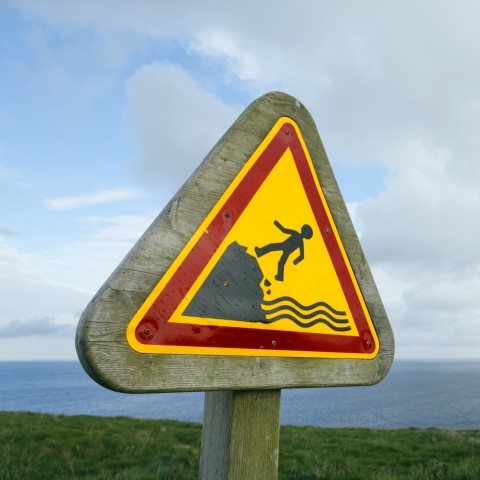
A sign warns of danger.
- Better safe than sorry. Prepare for the worst by learning Finnish phrases to use in an emergency.
3. Proverbs About Learning
Are you feeling discouraged with your Finnish studies, thinking about taking on a new hobby, or about to start classes at university? It sounds like you’re in need of some motivation and practical advice! Here are the best Finnish proverbs about learning to give you just that…
| Finnish | Kukaan ei ole seppä syntyessään. |
| Literally | “No one is a blacksmith when they are born.” |
| Equivalent | Practice makes perfect. |
| You need to put effort into learning new skills. Älä huoli, Antero! Jatka vaan harjoittelua—kukaan ei ole seppä syntyessään. “Don’t worry, Antero! Just keep practicing—no one is a blacksmith when they are born.” | |
| Finnish | Kertaus on kaikkien opintojen äiti. |
| Equivalent | Repetition is the mother of all learning. |
| Every language learner knows this! Repetition really helps you remember things, whether you’re learning grammar rules or new vocabulary. Sallan opettaja muistutti oppilaitaan aina ennen kokeita, että kertaus on kaikkien opintojen äiti. “Salla’s teacher always reminded her students before tests that repetition is the mother of all learning.” | |
| Finnish | Oppia ikä kaikki |
| Literally | “To learn at any age” |
| Equivalent | Live and learn. |
| Learning new things never ends! This proverb is especially apt when you come across a piece of information that you find surprising. En tiennyt, että Australiassa on pingviinejä. Oppia ikä kaikki. “I didn’t know that there are penguins in Australia. Live and learn.” | |

- Interested in reading more wise words about learning? Then visit our list of the Top 10 Quotes About Language Learning.
4. Proverbs About Family
The relationship we have with our family is precious, and it’s one of the most important relationships we’ll have in life. That said, here are a few Finnish proverbs on the topic of family!
| Finnish | Ei omena kauas puusta putoa. |
| Equivalent | An apple doesn’t fall far from the tree. |
| Children get not only their physical appearance from their parents, but often their character traits too—for good or for ill! Näyttää että Erkistä on tulossa yhtä taitava jääkiekonpelaaja kuin isästään. Ei omena kauas puusta putoa. “It looks like Erkki is becoming as talented an ice hockey player as his father. The apple doesn’t fall far from the tree.” | |
| Finnish | Veri on vettä sakeampaa. |
| Equivalent | Blood is thicker than water. |
| Familial ties are stronger than any other bonds we make throughout life. Vaikka tappelemme usein, olen aina valmis puolustamaan veljeäni, sillä veri on vettä sakeampaa. “Even though we fight often, I’m always ready to defend my brother, because blood is thicker than water.” | |

A family enjoys a walk in the woods.
- We have more wisdom on family ties for you! Check out our list of the Top 10 Quotes About Family.
5. Proverbs About Love
Whether you have a Finnish sweetheart or just want to learn some lighthearted quips on the topic of romance, these Finnish proverbs about love are exactly what you need!
| Finnish | Tie miehen sydämeen käy vatsan kautta. |
| Equivalent | The way to a man’s heart is through his stomach. |
| According to this proverb, cooking a delicious dinner may be the surest way to win a man’s affections. Kati on aina sanonut, että tie miehen sydämeen käy vatsan kautta. Ja ehkä hän on oikeassa—Katin oma mies kosi syötyään hänen lohikeittoaan! “Kati has always said that the way to a man’s heart is through his stomach. And perhaps she’s right—Kati’s own husband proposed after eating her salmon soup!” | |
| Finnish | Rakkaudesta se hevonenkin potkii. |
| Literally | “The horse kicks out of love too.” |
| This proverb claims that people sometimes show their love in very strange ways! Kaarina väittää, että Eemeli aina kiusaa Tanjaa siksi koska tykkää hänestä. Rakkaudesta se hevonenkin potkii, hän sanoi! “Kaarina claims that Eemeli is always teasing Tanja because he likes her. The horse kicks out of love too, she said!” | |
| Finnish | Vanha suola janottaa. |
| Literally | “Old salt makes one thirsty.” |
| This saying refers to a situation where one still harbors romantic feelings for someone from the past. Kuulitko, että Katri on taas nähty Esan kanssa? Taitaa vanha suola janottaa. “Did you hear that Katri has been seen with Esa again? Seems that old salt is making her thirsty.” | |

A couple enjoys a romantic dinner.
- Feeling romantic? Why not learn a few Finnish quotes about love?
6. Proverbs About Courage
Some of the best things in life are only achieved after facing one’s fears or making a bold move. Here are a couple of Finnish proverbs on the topic of courage.
| Finnish | Rohkea rokan syö. |
| Literally | “The brave will eat the soup.” |
| Equivalent | Fortune favors the bold. |
| If you want to achieve something great, you need to be brave and go for it. Why rokka (“soup” colloquial), though? Possibly because it alliterates with rohkea (“brave”)! According to the Tiede magazine, this Finnish proverb might be over a thousand years old. The brave one gets the catch and can fill his stomach. The proverb used to continue with …ujo kuolee nälkään, kaino ei saa kaaliakaan (“…the shy one will die of hunger, the coy one won’t get even a cabbage”). Rohkea rokan syö, ajatteli Salli mennessään pyytämään palkankorotusta. “Fortune favors the brave, thought Salli on her way to ask for a raise.” | |
| Finnish | Yrittänyttä ei laiteta. |
| Literally | “Who has tried will not be scolded.” |
| Equivalent | Nothing ventured, nothing gained. |
| You won’t get anything if you don’t try—and according to this proverb, a Finn will not judge you if you’ve done at least that much! (Note that “to scold” is an archaic meaning for the verb laittaa.) Tommia ärsyttää, jos joku luovuttaa yrittämättä—‘yrittänyttä ei laiteta’ on hänen mottonsa. “Tommi finds it annoying if someone gives up without trying—‘nothing ventured, nothing gained’ is his motto.” | |

A skydiver.
- Do you believe courage trumps caution when it comes to success? Read our list of the top 11 Finnish quotes about success to see what others think.
7. Proverbs About Being Home and Abroad
Do you love to travel or are you more of a homebody? (Or maybe a little bit of both?) In either case, here are some proverbs in Finnish that discuss travel and home time.
| Finnish | Oma koti kullan kallis. |
| Literally | “One’s own home is worth gold.” |
| Equivalent | Home sweet home. |
| Home: the best place in the world! Oma koti kullan kallis, Erja huokaisi laskiessaan matkalaukkunsa lattialle. “Home sweet home, Erja sighed as she put her suitcase down on the floor.” | |
| Finnish | Maassa maan tavalla. |
| Literally | “In a country according to its customs.” |
| Equivalent | When in Rome, do as the Romans do. |
| Anyone who’s traveled a lot knows to follow this golden rule! Adapting to local customs when abroad makes for richer experiences. Näytin varmaan hassulta kun yritin käyttää syömäpuikkoja, mutta maassa maan tavalla. “I probably looked silly when I tried to use chopsticks, but when in Rome, do as the Romans do.” | |
| Finnish | Oma maa mansikka, muu maa mustikka. |
| Literally | “One’s own country (is) a strawberry, another country a blueberry.” |
| Equivalent | “There’s no place like home.” |
| This proverb tells us that one’s own country is the best place in the world. Ulkomailla on aina kiva käydä, mutta en haluaisi asua missään muualla kuin Suomessa. Oma maa mansikka, muu maa mustikka, eikö totta? “It’s always nice to go abroad for a visit, but I wouldn’t want to live anywhere else but Finland. There’s no place like home, right?” | |

A family sits in front of their home.
- Are you planning to visit Finland? Then we recommend you learn some Survival Phrases in Finnish and the Top 30 Finnish Travel Phrases.
8. Miscellaneous Proverbs
To wrap up, let’s look at a few more Finnish proverbs on a variety of topics…
| Finnish | Mikä laulaen tulee, se viheltäen menee. |
| Literally | “What comes singing, goes whistling.” |
| Equivalent | Easy come, easy go. |
| Things that are easy to come by tend to be just as easy to lose. Or perhaps we simply don’t care that much about losing them! Kuulitko, että Kirsi voitti ison summan rahaa mutta kulutti sen kokonaan kahdessa kuukaudessa? Tyypillistä—mikä laulaen tulee, se viheltäen menee. “Did you hear that Kirsi won a great sum of money but spent it all in two months? Typical—easy come, easy go.” | |
| Finnish | Loppu hyvin, kaikki hyvin. |
| Equivalent | All’s well that ends well. |
| Often, it’s all about the happy ending—no matter what trials we had to get through first. Terhi myöhästyi omista häistään, mutta se ei onneksi pilannut juhlaa. Loppu hyvin, kaikki hyvin! “Terhi was late for her own wedding, but luckily it didn’t ruin the celebration. All’s well that ends well!” | |
| Finnish | Kolmas kerta toden sanoo. |
| Literally | “Third time speaks the truth.” |
| Equivalent | Third time’s a charm. |
| This one is slightly mysterious. Why are we more likely to succeed on our third try? Perhaps failing twice at something makes for an effective learning experience. Teppo oli pettynyt, kun hän ei läpäissyt ajokoetta toisellakaan yrittämällä. ’Kolmas kerta toden sanoo’, muistutin häntä. “Teppo was disappointed when he didn’t pass the driving test even on his second attempt. ‘Third time’s a charm,’ I reminded him.” | |
| Finnish | Parempi myöhään kuin ei milloinkaan. |
| Equivalent | Better late than never. |
| Even if it takes a long time to achieve something, it’s still better than not succeeding at all. Tuula kertoi minulle, että hän on vihdoin valmistunut. Niinkö? Parempi myöhään kuin ei milloinkaan! “Tuula told me that she has finally graduated. Really? Better late than never!” | |
| Finnish | Hätä ei lue lakia. |
| Literally | “An emergency does not read the law.” |
| Equivalent | Necessity knows no law. |
| Similar to the proverb “desperate times call for desperate measures,” this proverb asserts that in a dire situation, it may be necessary to break the law. Olen aina ollut lainkuuliainen, mutta kiperässä tilanteessa minäkin rikkoisin sääntöjä, sillä hätä ei lue lakia. “I have always been law-abiding, but in a tricky situation even I would break rules, because necessity knows no law.” | |
| Finnish | Tarkoitus pyhittää keinot. |
| Literally | “The purpose sanctifies the means.” |
| Equivalent | The end justifies the means. |
| Similar to the previous proverb, this proverb claims that unethical actions can be forgiven if the outcome is beneficial. A: ‘Sinä siis varastit auttaaksesi vähäosaisia?’ B: ‘Kyllä, tarkoitus pyhittää keinot, eikö niin?’ A: “So you stole to help the poor?”B: “Yes, the end justifies the means, doesn’t it?” | |
| Finnish | Paistaa se päivä risukasaankin. |
| Literally | “The day will shine even into a pile of twigs.” |
| Equivalent | Every dog has his day. |
| Do you ever feel like everything is going wrong for you? This proverb is here to assure us that even the most unfortunate will enjoy success at times! Sanoin Petterille ettei pidä koskaan luovuttaa, koska paistaa se päivä risukasaankin. “I told Petteri that one should never give up, because every dog has his day.” | |
| Finnish | Vaihtelu virkistää. |
| Literally | “Change refreshes.” |
| Equivalent | Variety is the spice of life. |
| Big or small, changes can indeed be refreshing. Janne ja Elina päättivät yhtäkkiä muuttaa maalle. Kun kysyin heiltä miksi, he sanoivat vain että vaihtelu virkistää. “Janne and Elina suddenly decided to move to the country. When I asked them why, they simply said that variety is the spice of life.” | |
| Finnish | Hädässä ystävä tunnetaan. |
| Literally | “In an emergency, a friend is known.” |
| Equivalent | A friend in need is a friend indeed. |
| True friends will support you when you’re in trouble, while fair-weather friends quickly disappear. Sirpa ei epäröinyt hetkeäkään kun pyysin apua. On totta, että hädässä ystävä tunnetaan! “Sirpa didn’t hesitate even for a moment when I asked for help. It’s true that a friend in need is a friend indeed!” | |
| Finnish | Aika parantaa haavat. |
| Literally | “Time heals wounds.” |
| Equivalent | Time heals all wounds. |
| According to folk wisdom, even the bitterest disappointment and the worst kind of heartbreak will heal over time. Avioero on usein tuskallinen kokemus, mutta aika parantaa haavat. “A divorce is often a painful experience, but time heals all wounds.” | |
Have you experienced heartbreak? Read our list of Finnish Break-Up Quotes to read what others have to say about it.

Hädässä ystävä tunnetaan. / “A friend in need is a friend indeed.”
9. Lopuksi
In this guide, we dived deep into Finnish wisdom and learned some of the most commonly used Finnish proverbs about a variety of topics, from courage to love. Were there any that you particularly liked or had heard before? If you know any other Finnish proverbs, feel free to share with the community by leaving a comment below!
We have a lot for you to explore on FinnishPod101.com if you’re interested in learning more about the Finnish language and culture. Get started with our free Finnish resources, or take a look at our expansive collection of Finnish vocabulary lists with audio recordings. Have fun learning with FinnishPod101!

Visit Helsinki: Top 10 Places in the Daughter of the Baltic

As a travel destination, Helsinki is still a bit of a hidden gem, unspoiled by mass tourism. But while it may be considered ‘out of the way’ by many, Finland’s quirky capital has enough charm to rival any European metropolis. Expect a vibrant seaside city graced with stunning Art Nouveau architecture, plenty of tranquil green spaces and islands, world-class attractions, and a lively cultural scene.
Whether you’re into history, art, shopping, or nature, or simply love to stroll around and soak in the atmosphere, Helsinki has much to offer. But before you visit Helsinki, we recommend you learn all you can about the area and prepare. In this Helsinki travel guide, we’ll cover general information about the city before moving on to the top ten sights and experiences not to miss when visiting.

Helsinki is a vibrant northern seaside city with plenty of character.
 Table of Contents
Table of Contents
- Travel Tips
- Must-See Places in Helsinki for a 1-3 Day Trip
- Highly Recommended Attractions in Helsinki for a Longer Trip
- Survival Finnish for Travelers
- Lopuksi
1. Travel Tips
Helsinki lies on the southern coast of Finland by the Baltic Sea. It’s Finland’s capital and the country’s largest city, with over 600,000 inhabitants. The city was founded in 1550 by King Gustavus Vasa of Sweden, though it wasn’t until 1812 (while Finland was an autonomous Grand Duchy of Russia) that Helsinki became the capital city.
The city is called Helsingfors in Swedish, which is Finland’s other official language.
When to Visit
When determining the best time to visit Helsinki, weather and tourist trends are both important considerations.
Most people choose to visit Helsinki in summer (from June to August), and for good reasons: the days are long, the weather is at its warmest, and all of the tourist attractions are open. On the flipside, the cost of accommodation is also at its highest and you’re more likely to run into crowds and long lines.
If you don’t mind the cold and darkness, visiting Helsinki in the winter (from December to February) is a more budget-friendly option. This is also a great season to enjoy the capital’s nightlife. In winter, you could even try your hand at ice skating or cross-country skiing!
It’s also worth checking out the capital’s festival diary when planning a trip—there are a lot of quirky events and festivities taking place in Helsinki throughout the year.
Getting Around
Thanks to the city’s compact size, many of Helsinki’s key attractions can be easily reached on foot or by bicycle (you can rent one for up to five hours for a small fee). The city also boasts one of the best public transportation systems in the world: the metro, trams, buses, local trains, and the Suomenlinna ferry are all operated by the Helsinki Regional Transport Authority (HSL) with Nordic efficiency.
If you’re planning to see a lot during your visit, it may be worth it to purchase a Helsinki Card, which includes free travel on the city’s public transportation during the card’s validity period.
Language
Finland is a bilingual country, and both Finnish and Swedish will typically feature on maps and signs. However, most people you’ll come across in Helsinki will speak Finnish as their mother tongue and usually aren’t fluent in Swedish. Most people here can communicate reasonably well in English though, and they’re usually happy to do so. This makes it possible to get by using only English in Helsinki, but learning even a little bit of Finnish ahead of your trip is highly recommended—locals will appreciate the effort and it will make your travel experience far more immersive!
Sleeping
Mid-range chain hotels make up a large portion of the accommodation options on offer in Helsinki, and you can expect to pay an average of 114 euros for a twin room per night. The cheapest dorm beds will cost around 23 euros per night, while you could also splash out and stay at the prestigious Hotel Kämp, where their most modest rooms will set you back by 265 euros per night. For a truly unique experience, look for Hotel Katajanokka, which is a former prison!
Eating
Eating out at an inexpensive restaurant (you’ll usually have to head out of the city center to find them) will cost about 12 euros per person, while you can grab a meal at most fast food joints for 8 euros or less. Helsinki also has several Michelin Star restaurants: a fine dining experience with drinks at Restaurant Olo, for example, will cost 261 euros per guest.
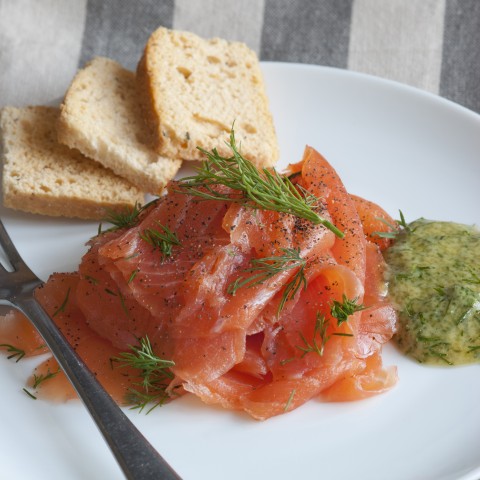
You’re likely to see a lot of fish on the menu in Helsinki.
2. Must-See Places in Helsinki for a 1-3 Day Trip
Are you in Helsinki for only a day or two, but still want to fit in the most essential experiences the city has to offer? Then look no further than our list of the top five things to see and do in Helsinki on a very short trip!
1 – Helsingin Tuomiokirkko (“Helsinki Cathedral”)
No trip to Helsinki would be complete without taking a peek at the city’s iconic landmark, with its large green central dome and luminous white-washed walls towering above Senaatintori (“The Senate Square”). Modeled after St. Isaac Cathedral in Saint Petersburg, the beautiful Helsinki Cathedral was built in honor of the Grand Duke of Finland, Tzar Nicholas, in 1852. If you have the time, it’s worth climbing up the steps for lovely views over the surrounding area!
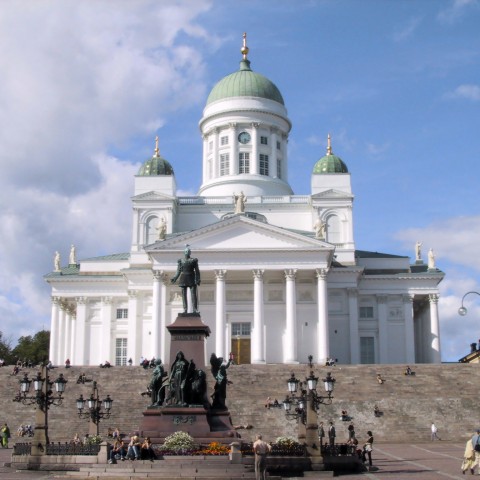
Helsinki Cathedral above the Senate Square
2 – Suomenlinna (“Suomenlinna Fortress”)
Suomenlinna literally means “castle of Finland.” However, it isn’t an actual castle but rather an atmospheric sea fortress built on a cluster of rocky islands in the Baltic Sea. The military base was constructed in the eighteenth century and has since been held by Swedish, Russian, and Finnish forces in turn and has many fascinating tales to tell!
Today, this unique site is one of the most popular attractions in Helsinki (drawing close to a million visitors every year) as well as the home of around 800 local residents. Suomenlinna has been on the UNESCO World Heritage List since 1991.
Suomenlinna is free to enter and can be easily reached by ferry. There’s enough to see here for an entire day trip, if you can spare the time. In addition to all the historic military structures, you’ll find…
- …six museums.
- …Finland’s only remaining WWII-era submarine.
- …a church doubling as a lighthouse.
- …artists’ workrooms.
- …souvenir shops.
- …a brewery.
- …cafés.
- …many tranquil spots that are perfect for enjoying a relaxing picnic.

Suomenlinna Fortress
3 – Kauppatori (“The Market Square”)
While you’re checking out the Helsinki Cathedral and the Suomenlinna Fortress, be sure to take some time to explore the nearby Market Square too. The square’s been a busy trading spot for hundreds of years, and it continues to attract both locals and visitors in large numbers.
This is the perfect place to shop for fresh produce as well as arts and crafts. If you time your visit just right, you could catch a themed market or a special event, such as the famous Baltic Herring Market in October. Summer is by far the busiest time at the Market Square, but even in winter it’s worth coming here for a steaming cup of coffee with a sea view.
The nearby Kauppahalli (“The Old Market Hall”) is a must for foodies: a great variety of merchants, from chocolatiers and bakers to butchers and cheesemongers, sell their products in this eye-catching building that’s been in use since 1889.
4 – Suomen Kansallismuseo (“The National Museum of Finland”)
Finland’s history is complex and interesting, and you can experience it in an entertaining, interactive way at the National Museum of Finland. Your journey begins with the prehistoric era, continues through the centuries spent under Swedish and Russian rule, goes on to illustrate Finland’s struggle for independence, and finally ends in present-day Finland.
If you’ve ever wondered why Finns are so into saunas, heavy metal, and the Moomins, you’ll find many clues here, all presented with a touch of self-deprecating Finnish humor. You’re guaranteed to walk away from your experience understanding Finns a bit better!
5 – Visit a Public Sauna
You haven’t truly experienced Finland until you’ve spent some time sweating in a small, steam-filled room—also known as going to a sauna—so please make sure to leave enough time in your Helsinki itinerary for this experience when planning your trip!
There are lots of saunas to choose from in the capital. For a traditional sauna, try Kotiharjun Sauna, Sauna Arla, Sauna Hermanni, or Kaurilan Sauna. The latter is a wooden sauna dating back to the nineteenth century—you won’t even find electric lights here to mar the authentic old-school sauna experience.
For a more modern sauna visit, check out the celebrated Löyly in the Hernesaari district, or the Allas Sea Pool by the Market Square. Both offer multiple sauna rooms as well as a chance to dip in the Baltic Sea to cool down.
And finally, if you’ve ever wondered what it would be like to sit in a sauna and a ferris wheel at the same time, you can do just that at Helsinki’s SkySauna!
- ❖ Nervous? Read helpful tips for first-time sauna-goers.
- Hei. (“Hello.”)
- Kiitos. (“Thank you.”)
- Näkemiin. (“Goodbye.”)
- Anteeksi. (“Sorry.”)
- Oikein hyvä. (“Very good.”)
- En ymmärrä. (“I don’t understand.”)
- Missä on vessa? (“Where is the restroom?”)
- Kuinka paljon se maksaa? (“How much is it?”)
- Haluan tämän. (“I want this.”)
- Apua! (“Help!”)
- Common Ways to Say Hello
- 10 Lines You Need for Introducing Yourself
- Top 30 Travel Phrases You Should Know
- The Top 10 Ways to Prepare for Travel in Finnish

3. Highly Recommended Attractions in Helsinki for a Longer Trip
If you have a bit longer to spend in Helsinki, there’s no shortage of other great attractions to check out on your trip. Here’s what to visit around Helsinki for a longer visit.
6 – Nykytaiteen Museo Kiasma (“The Museum of Contemporary Art Kiasma”)
Part of the Finnish National Gallery, alongside the Ateneum Art Museum and the Sinebrychoff Art Museum, Kiasma is the place to go see contemporary Finnish art. The name of the art museum—a term that describes the crossing of nerves, tendons, or chromosome strands—symbolizes the museum’s intention to provide meaningful and memorable encounters with art for their visitors.
Kiasma offers something for all ages, with plenty of fun, interactive elements, guided tours, art workshops, and live performances featuring experimental drama, music, and dance. The building itself is worth seeing, too. Designed by Steven Holl, the art museum is one of Helsinki’s most striking examples of modern architecture.

An aerial view of the Museum of Contemporary Art Kiasma
7 – Seurasaaren Ulkomuseo (“Seurasaari Open-Air Museum”)
If the bustle of the city gets tiring at any point, we recommend stepping back in time to experience Finland’s rural past in a peaceful woodland setting on the island of Seurasaari. The open-air museum features a collection of authentic timber buildings dating back up to 400 years from different parts of Finland, including a church, a manor house, cottages, and workshops, complete with traditional furniture and objects.
During the summer season, there are frequent arts and crafts markets and other events, and you can join a tour to learn more about rural life in Finland over the past centuries. During the winter months, entry to the site is free but the buildings are closed to visitors.
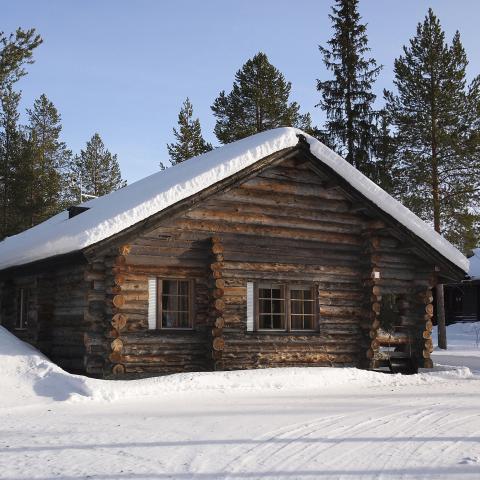
An old wooden building in the snow
8 – Linnanmäki (“Linnanmäki Amusement Park”)
Linnanmäki Amusement Park was founded by several child welfare organizations in 1950 and it continues to raise funds for children in need to this day. The park is hugely popular, attracting over a million visitors per year who flock here to enjoy thrilling rides, arcade games, and live shows.
The most iconic ride in Linnanmäki is its old wooden roller coaster. Opened in 1951, it’s one of the few roller coasters in the world that’s still operated by brakemen! Adjacent to the amusement park, you’ll also find Sea Life, an aquatic wonderland where you can meet a large variety of marine creatures, from starfish to sharks.

9 – Korkeasaaren Eläintarha (“Korkeasaari Zoo”)
Did you know that you can run into forest reindeer and brown bears in Helsinki? Well, you do need to head over to the Korkeasaari Zoo for that experience, but if you’re interested in seeing these famous Finnish animals with your own eyes, a visit to Korkeasaari is a must. Other indigenous species on the island (yes, Korkeasaari is another island!) include elk and wolverine.
The zoo houses 150 different animal species in total, including many exotic inhabitants, such as pygmy marmosets and Amur tigers. Korkeasaari is among the oldest zoos in the world, and it’s known for its successful breeding programs for endangered species and onsite conservation work to protect key habitats around the world.
Korkeasaari is open every day of the year, and its heated tropical houses are a particularly lovely place to enjoy on chilly winter days!
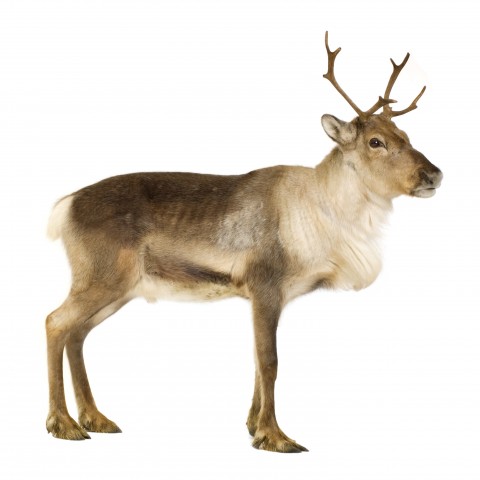
Meet reindeer in Korkeasaari.
10 – Temppeliaukion Kirkko (“Temppeliaukio Church”)
Also known as “The Rock Church,” Temppeliaukio Church is one of Helsinki’s most curious buildings. Most of the building lies underground, with the interior of the church carved directly out of bedrock; only the central dome is fully visible from the outside. The unique idea for the church was conceived by the architect brothers Timo and Tuomo Suomalainen, who won a design competition in the 1960s.
To see the church from the inside, check the opening times in advance to avoid disappointment—the church is used for worship and is therefore not always open to visitors. Temppeliaukio Church is also the only church in Helsinki that collects a small entrance fee (this is due to its popularity among visitors to Finland).

4. Survival Finnish for Travelers
While you can (probably) get by in Helsinki without speaking any Finnish, you’ll make a great first impression by taking the time to learn at least a few key phrases, starting with a friendly greeting!
Here are the top ten Finnish travel phrases to learn before your trip to Helsinki:
You can find much more useful travel-related vocabulary on FinnishPod101.com:
All of our vocabulary lists come with recordings, so you can practice your pronunciation with confidence. For a more comprehensive guide, refer to our article on the Must-Know Finnish Travel Phrases.
Lopuksi
In this guide, we’ve talked about the best places and experiences that Helsinki has to offer, from intriguing historic sites and quirky buildings to fascinating museums and the most note-worthy public saunas. We hope that you’re feeling excited about visiting “the Daughter of the Baltic”! If you could spend as long as you wanted in Helsinki, what would you add to our list? Share your own travel tips with us in the comments!
Take some time to explore FinnishPod101.com while you’re preparing for your trip, and be sure to make use of all our free resources. We have an ever-growing collection of vocabulary lists to help you learn new Finnish words on almost any subject you could think of, while our lessons are specially designed to get you talking Finnish fast. Happy learning!

English Words in Finnish: A Guide to Finglish and Loanwords

It’s always fun to spot a familiar word or two when you’re learning a new language—it’s like getting a freebie! English loanwords are common in many languages, and plenty have been incorporated into Finnish over time. The earliest English loanwords were introduced into Finnish in the nineteenth century. Globalization and the internet have accelerated the process, and new loanwords are entering our language faster than ever. Sometimes, English is mixed so liberally with Finnish that the end result is known as Finglish.
In this article, we’ll answer your burning questions about English words in Finnish. For example, what exactly is Finglish? And how do you tell the difference between Finglish and the use of loanwords? Do loanwords change over time? Are English loanwords and Finnish grammar a good fit? How do Finns feel about the influx of English words? Are there any Finnish loanwords in the English language?
Let’s find out!

Languages have always influenced one another.
 Table of Contents
Table of Contents
- Finglish and Loanwords – What’s the Difference?
- English Loanwords in Finnish
- More About Finglish
- When Finnish and English Clash
- Finnish Loanwords in English
- Lopuksi
1. Finglish and Loanwords – What’s the Difference?
First of all, let’s clarify the difference between the use of English loanwords and speaking Finglish.
Loanwords
Loanwords are words that have crossed from one language to another and have become more or less established. These words may retain their original spelling and pronunciation in their new environment, though they may also be adapted in different ways to better fit within the structures of the host language.
Why do we use loanwords? Often, English loanwords are borrowed when a native Finnish word doesn’t yet exist for that thing (this is commonly the case with technological terminology). Other times, an English word may be borrowed because it’s more succinct, exact, or comprehensive than a Finnish alternative—or just because it’s trendy!
In a bit, we’ll take a look at three different categories of English loanwords used in Finnish.
Finglish
The word ‘Finglish’ was first coined to describe the language spoken by Finnish immigrants in North America. Today, speaking Finglish refers to the act of peppering one’s Finnish with an excess of English words and expressions to such an extent that the end result sounds like some sort of strange hybrid language. We’ll come back to Finglish later in this article.

Finglish is strongly associated with internet slang and youth culture.
2. English Loanwords in Finnish
As you learn Finnish, you’ll come across many loanwords that you’ll instantly recognize. There are other loanwords that may look familiar yet strange at the same time. The difference usually comes down to how long ago the word was borrowed. The longer a loanword has been used in Finland, the more likely it is that it has gradually changed to resemble native Finnish words.
Let’s look at three different groups of loanwords.
Non-Integrated Loanwords
This type of loanword is known as sitaattilaina (literally: “citation loan”) in Finnish. These words are borrowed from English exactly as they are, complete with their original spelling and pronunciation. In other words, these are the true freebies for a language learner!
Non-integrated English loanwords are frequently seen in the fields of technology, business, social media, food, music, and sports. Proper nouns (such as Sydney) are also adopted from English without any changes.
A loanword may also appear as part of a compound word:
- cashewpähkinä (“cashew nut”)
Sometimes, a Finnish term exists but the English loanword is more popular. For example, popcorn is used far more often than paukkumaissi.
Let’s take a look at some examples of these common English words in Finnish:
Information technology
- Bluetooth
- Internet
- Hands free
- Online
Hands free – laitteiden kysyntä on selvästi vähentynyt.
“The demand for hands-free devices has clearly decreased.”
- → Can you spot other English loanwords on our technology vocabulary list?
Food
- Popcorn
- Smoothie
- Brownie
- Hot dog
Hanna-tädin browniet ovat ihania.
“Aunt Hanna’s brownies are wonderful.”
- → Learn how to say “I am going to buy popcorn and drinks,” and other useful Finnish words and phrases for going to the movies on FinnishPod101.com.
Sports
- Curling
- Squash
- Baseball
- Golf
Tiesitkö, että curling kehitettiin Skotlannissa?
“Did you know that curling was developed in Scotland?”
- → Spot even more familiar words on our Olympic sports vocabulary list.
Work
- Freelance
- Bonus
- Copywriter
- Deadline
Yrityksemme uusi copywriter aloitti työt viime maanantaina.
“The new copywriter in our company started working last Monday.”
- → Learn the word for ‘Christmas bonus’ on our vocabulary list for talking about the workplace in Finnish.
Music
- Rock
- Pop
- Blues
- Heavy metal
Heavy metal on todella suosittu musiikkilaji Suomessa.
“Heavy metal is a really popular musical genre in Finland.
- → “Learn more Finnish music vocabulary on FinnishPod101.com.

Finns favor the word popcorn over paukkumaissi.
Partially and Fully Integrated Loanwords
Non-integrated loanwords tend to be relatively new additions to the Finnish language. That’s because few English loanwords survive in their original form forever; most go through various changes over time to make them a more natural fit for Finnish.
Remember how Finnish has an almost complete agreement between letters and sounds? A lot of the changes that loanwords undergo simply reduce the discord between pronunciation and spelling.
Common changes to loanwords include:
- The replacement of letters like b, d, g, f, x, and q with letters that are more common in Finnish
- The replacement of the letters a and o with the letters ä and ö to more accurately reflect the pronunciation of a loanword
- The duplication of the final consonant
- The addition of i to the end of a word
The last change is extremely common. It applies, for example, to ‘-isms’ borrowed from English, including kapitalismi (“capitalism”).
Can you tell what changes these loanwords went through?
- Elektroni (“Electron”)
- Taksi (“Taxi”)
- Brändi (“Brand”)
- Trendi (“Trend”)
- Viski (“Whisky”)
- Pekoni (“Bacon”)
- Vinssi (“Winch”)
- Tiimi (“Team”)
- Greippi (“Grapefruit”)
Confusing to language learners and native Finns alike, both the original spelling and an adapted spelling of the same word may be in use. For example, take a look at these two musical genres:
- jazz / jatsi (“jazz”)
- country / kantri (“country”)
Loanwords can also exist simultaneously with endemic Finnish words:
- läppäri / kannettava (“laptop”)
- printteri / tulostin (“printer”)

The English word “team” has evolved into tiimi in Finnish.
Calques
Our final category of English loanwords in Finnish is one that causes zero problems with pronunciation, spelling, or inflection: käännöslainat (“calques,” or literally “translation loans”). These are word-for-word translations of English compound words or word pairs.
- Jalkapallo (“Football”)
- Sähköposti (“Electronic mail”)
- Kotisivu (“Homepage”)
- Maksumuuri (“Paywall”)
- Musta aukko (“Black hole”)
- Sohvaperuna (“Couch potato”)
- Emolevy (“Motherboard”)
- Baarikärpänen (“Bar fly”)
- Lasikatto (“Glass ceiling”)
- Haamukirjoittaja (“Ghost writer”)
- Hyvinvointivaltio (“Welfare state”)
- Luottokortti (“Credit card”)
Idioms hop from English to Finnish as translation loans, as well:
- Kieli poskessa (“Tongue in cheek”)

The word luottokortti (“credit card”) is a translation loan.
3. More About Finglish
As promised, here’s some detailed information on Finglish for you!
North American Finglish
The word ‘Finglish’ was originally coined in the 1920s by Professor Martti Nisonen. He was referring to the mixture of Finnish and English spoken by Finnish immigrants in the United States and Canada. The Finnish term for it is amerikansuomi (“North American Finnish”). Examples of Finglish used by American Finns include:
- leeki (from ‘lake’)
- milkki (from ‘milk’)
- tätsrait (from ‘that’s right’)
- haussi (from ‘house’)
- äpyli (from ‘apple’)
New Finglish
In Finland today, the term ‘Finglish’ refers to the end result of native Finnish speakers using excessive English terms and expressions. Finglish is strongly associated with young people, though IT professionals and business people have also gained a reputation for relying a little too heavily on English terminology.
Finglish absorbs new English vocabulary and expressions, particularly from TV, cinema, music, social media, and various subcultures.
Characteristics of Finglish include a liberal use of English words as they are (like “anyway,” “basically,” and “about”) and a frequent adaptation of new English words. These adapted words differ from regular English loanwords in the sense that they sound like slang—although the line between the two can become rather blurred!
Here are a few terms that are considered Finglish (the first word) with their equivalent Finnish terms (the second word) for comparison:
- Biitsi / Hiekkaranta (“Beach”)
- Kreisi / Hullu (“Crazy”)
- Keissi / Tapaus (“Case”)
- Bugi / Ohjelmointivirhe (“Bug” – in IT)
There are also new verbs derived from English that follow Finnish conjugation rules:
- Skipata (“To skip”)
- Klikata (“To click”)
- Tsekata (“To check”)

Many IT-related words like Ethernet have been borrowed from English.
4. When Finnish and English Clash
Now you know what Finglish and loanwords look like in Finnish, but how do they affect the language and those who speak it? Take a look.
How Do Finns Feel About English Loanwords?
Unlike countries such as Iceland and France, Finland has no official rules to regulate the introduction of new loanwords. However, Kielitoimisto does provide guidance and recommendations on how to use them.
While many Finns embrace English loans, many others are deeply skeptical. In one survey, the participants were almost evenly divided on the matter. The narrow majority of respondents felt that loanwords enrich the Finnish language and are often necessary. For example, they would welcome loanwords if a Finnish alternative didn’t exist or was clumsy compared to a loanword.
Those who felt uneasy about the introduction of English loanwords felt that there were already too many and that they can be very difficult to spell and pronounce. The latter group expressed a desire for active efforts to coin new Finnish terms to replace loanwords.
When English Loanwords Meet Finnish Grammar
Inflecting (non-integrated) English loanwords according to Finnish grammar rules can feel like forcing a square peg into a round hole—the two are often not compatible. A lot of the trouble and confusion stems from the fact that Finnish pronunciation is very different from English pronunciation. This creates a dilemma: should Finnish grammar rules like vowel harmony be applied according to a word’s spelling or according to its pronunciation? Should consonant gradation apply to loanwords at all?
There’s usually no perfect solution, and the best course of action may be to tweak sentences to avoid inflecting loanwords in the first place. When this isn’t possible, Finns may have to make a choice between an option that ‘looks wrong’ and one that ‘sounds wrong.’
This is probably the greatest driver behind the adaptation of loanwords in Finnish. When a loanword is tweaked into a more Finnish-friendly form, it becomes far easier to inflect with confidence.

A man with a puzzled look on his face.
5. Finnish Loanwords in English
By now, you may be wondering if there are any Finnish words in the English language. The short answer is: not many! It’s been mostly a one-way street between Finnish and English as far as loanwords are concerned.
The most famous Finnish loanword in English is sauna. The other loans are decidedly more niche, such as rapakivi (a type of granite rock) and palsa (a permanently frozen peat mound).

Finnish sauna.
Lopuksi
In this guide, we’ve discussed various types of English loanwords that are used in Finland, Finns’ attitudes toward them, and the grammar problems they sometimes cause. We’ve also looked at the strange hybrid language known as Finglish, and how it differs from the use of established English loanwords.
We’ve listed some of the most common English words used in the Finnish language, but naturally, there are a lot more out there. Do you know of any that we didn’t mention in this article? Feel free to share them by leaving a comment below!
Keep your eyes peeled for more familiar words on our Finnish vocabulary lists on FinnishPod101.com, or head over to our free resources for an overview of Finnish pronunciation, grammar tutorials, and much more.

An Overview of the Finnish Culture

Are you thinking of visiting Finland? Or have you heard about Finland in the news recently and wanted to know more about the country? Whatever brought you here, know that we’ll do our best to satisfy your curiosity about the Finnish culture!
Geographically, Finland lies between Scandinavia and Russia. While the country has been culturally influenced by its neighbors on either side, it has a very distinctive cultural identity of its own with many interesting quirks and unique traditions.
Read on to learn more about Finland’s culture and traditions, from Finnish values and attitudes to popular sports, foods, and holidays. Trust us, there’s much more to Finnish culture than the sauna!
 Table of Contents
Table of Contents
- Finnish Character and Values
- Religion in Finland
- Sports and Recreation
- Finnish Art and Entertainment
- Finnish Food and Drink
- Holidays and Celebrations
- Lopuksi
1. Finnish Character and Values
To really understand the culture of Finland, you must first begin to understand the core values of Finnish society. Here are a few key points on the character and values of Finns!
A- Finnish Stereotype vs. The Reality
Finns have a reputation for being quiet and reserved, or even taciturn and unapproachable. Finns themselves may perpetuate this stereotype by telling self-deprecating jokes about their social awkwardness—a good example of this is the popular comic Finnish Nightmares created by the artist Karoliina Korhonen.
But is Finland really a country full of shy and withdrawn introverts? While there’s probably a grain of truth in every stereotype—in general, Finns do value their personal space and prefer meaningful conversations over idle chit chat—you’ll find that once you get to know them, Finnish people are usually very warm and open. Many have a charmingly dry sense of humor, and very talkative, highly extroverted Finns do exist!

A smiling little girl hides under her hat.
B- Finnish Core Values
The fairly liberal Finnish culture values freedom of speech, individualism, and tolerance. Finns believe in fairness and equal opportunities, especially when it comes to gender and women’s rights. Recently, Finland has attracted a lot of attention internationally for being led by an all-female coalition government.
Finns generally trust the authorities and they tend to be very honest and law-abiding. This is for a good reason: corruption is very low in Finland. The Corruption Perceptions Index ranks Finland as the third most transparent country in the world after Denmark and New Zealand.
In Finland, everyone has access to a free, world-class education, and the country was ranked the world’s most literate nation in 2016. Reading for pleasure as well as keeping up with the news are important to many Finns.
Finally, Finnish people have a very close connection to nature, and spending time outdoors is an essential aspect of living a high-quality life. There are forty national parks across the country, and conservation and environmental issues are taken seriously in Finland.

Sunlight seeps through trees in a forest.
C- Subcultures in Finland
Of course, Finland is not completely homogenous culturally. Notable subcultures with their own distinct characteristics and traditions include the Swedish-speaking Finns (suomenruotsalaiset), the Sami (saamelaiset), and the Finnish Gypsies (Suomen romanit). Head over to Wikipedia to learn more about these subcultures.
2. Religion in Finland
Before Christianity spread to Finland in the eleventh century, the country’s primary religion was Finnish paganism, which involved things like song magic and the worship of a variety of deities, including Ukko, the god of thunder.
The majority of Finnish people today consider themselves Christian, with roughly 69% of the population belonging to the Evangelical Lutheran Church of Finland. The Orthodox Church of Finland is the second-largest religious community in the country (a little over 1% of the population are members), while around 29% of Finns don’t consider themselves affiliated with any particular religion.
According to the Finnish Constitution, the Church and the State are separate entities, and Finns are free to practice any religion (or none). However, the Lutheran Church and the Finnish Orthodox Church enjoy certain privileges in the country, including the right to tax their members.
Typically, Finnish people are fairly secular in their views and religion does not play a major role in everyday life. Most Lutherans attend church only on special occasions (such as for weddings and funerals) or on major Christian holidays (such as Easter and Christmas).

A couple on their wedding day.
3. Sports and Recreation
Every culture has its favorite sports and preferred recreational activities. So how do sports and recreation come into play in Finnish culture and traditions?
A- Popular Sports in Finland
Both participating in and watching sports are popular pastimes in Finland. The national game is called pesäpallo (“Finnish baseball”), and the sports that get the most media coverage include jääkiekko (“ice hockey”), jalkapallo (“football”), and Formula 1 (“Formula One”).
Professionally, Finns have often excelled in winter sports, which isn’t surprising considering the long winters in Finland! Matti Nykänen was arguably the best ski jumper to have ever competed, and Finland’s national ice hockey team is among the best in the world, having won their third world championship title in 2019.
Finland is also the home of some very unique sports, including eukonkanto (“wife-carrying”) which originated in Sonkajärvi, and suopotkupallo (“swamp football”) which was initially an exercise activity for athletes and soldiers.
- Listen to our audio lesson to learn more about popular sports in Finland.
B- Recreational Activities
Finns enjoy many outdoor activities in their free time. Some typical hobbies include cross-country skiing, snowboarding, ice skating, Nordic walking, camping, and foraging for wild berries and mushrooms. Wild swimming is very popular in summer, but the most enthusiastic wild swimmers continue their hobby even during the coldest months of the year by creating a hole in the ice and going for a dip in the icy water!
Many Finns also enjoy relaxing activities, such as reading, cooking, playing music, and various arts and crafts from photography to knitting.
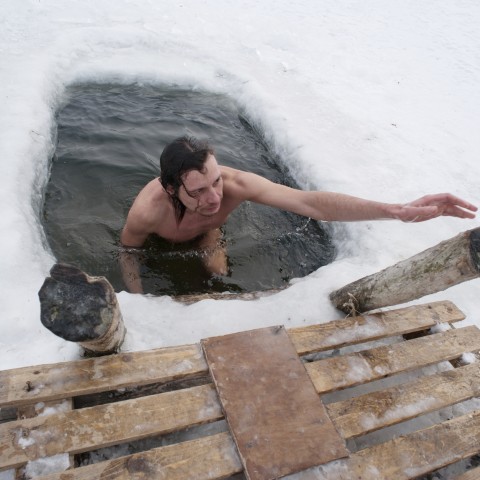
Wild swimming in winter.
- Head over to our audio library to learn how to talk about hobbies in Finnish.
4. Finnish Art and Entertainment
As can be said of many cultures, the culture in Finland is largely represented through its variety of artwork and entertainment mediums.
The most representative Finnish visual art style is known as Romantic Nationalism. The Kalevala-inspired paintings of Akseli Gallen-Kallela are among the most famous examples of this style. Tom of Finland (Touko Laaksonen) is possibly the most recognized Finnish artist internationally—his once-controversial drawings of gay men are today seen as symbols of open-mindedness and tolerance.
There is a distinct design tradition in Finland. Some of the most notable names in Finnish design include Alvar Aalto, Marimekko, and Iittala. Finnish architecture is particularly known for its extensive use of wood as material.
The most famous writers from the early days of Finnish literature include the novelist Aleksis Kivi and the poet Eino Leino. After Finland gained independence, modernist writers such as Mika Waltari and Frans Eemil Sillanpää (the only Finnish recipient of the Nobel Prize in Literature to date) rose to fame, while the Second World War inspired the best-selling novel Tuntematon sotilas (“The Unknown Soldier”) by Väinö Linna. Tove Jansson’s Moomin stories are among the most beloved Finnish children’s books of all time.
While Hollywood films are very popular in Finland, Finnish cinema is alive and well. Known for his extremely minimalistic style, Aki Kaurismäki is the best-known Finnish film director outside of his home country. His award-winning works include The Man Without a Past and Le Havre.
Many different styles of home-grown music are popular in Finland, including folk, rock, hip hop, dance, and pop. Internationally, Finland is perhaps best known for the classical composer Jean Sibelius as well as the prominent heavy metal music scene. The gothic rock band HIM is among the most commercially successful Finnish groups of all time and the first one to have received a gold record in the States.
Video and mobile games are considered a valued part of Finnish culture, with over twenty educational institutions providing instruction in game design. Some of the most acclaimed games developed by Finnish studios include the hit titles Max Payne, Angry Birds, and Clash of Clans.
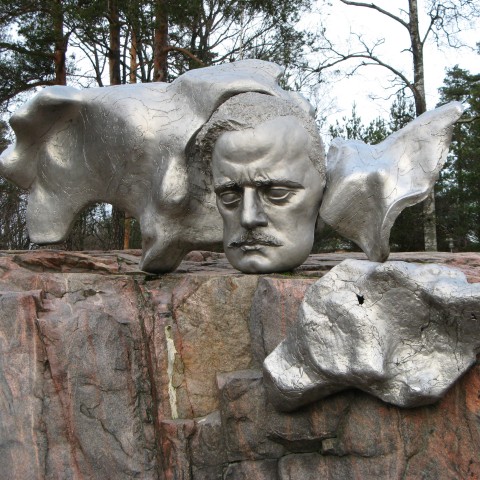
Sculpture of composer Jean Sibelius.
5. Finnish Food and Drink
A flavorful window into Finnish culture, food here is hearty, simple, and prepared with fresh ingredients. Meat, fish, dairy products, potatoes, and whole grains feature heavily in the Finnish diet. Wild mushrooms and berries are also commonly used when in season.
A- Top 5 Finnish Dishes
Are you curious about traditional Finnish food? Here are five delicious dishes to try:
- Lohikeitto (“Salmon soup”)
This comforting soup with potatoes, cream, and fresh dill is one of the best ways to enjoy salmon.
- Poronkäristys (“Sautéed reindeer”)
Prepared with thinly sliced reindeer meat seasoned with salt and pepper, this is a must-try traditional dish from the Finnish Lapland.
- Karjalanpaisti (“Karelian hot pot”)
Another dish proving that simple doesn’t mean bland! Meat, onion, and root vegetables are flavored with peppercorns and cooked for several hours in the oven.
- Kaalilaatikko (“Cabbage casserole”)
To prepare this dish, a mixture of cabbage, meat, and rice (or barley) is baked in the oven until perfectly tender.
- Kalakukko (“Fish pie”)
This traditional Savonian dish is prepared by baking fish (usually vendace or European perch) and pork wrapped inside a thin rye crust.
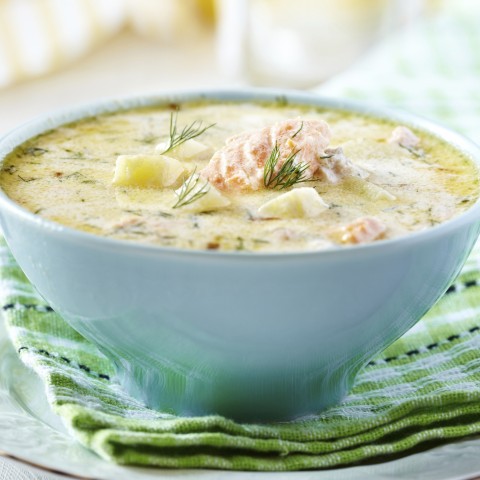
Finnish salmon soup.
B- Popular Products in Finland
If you get a chance to visit Finland, you’ll very quickly notice that certain food products are ubiquitous. The undisputed number-one bread in Finland is rye bread, Finnish cinnamon rolls can be found in almost every café, and a type of salty liquorice known as salmiakki (“salmiac liquorice”) is by far the most popular kind of sweet in the country.
What about drinks? Finns drink *a lot* of coffee—in fact, Finnish people consume more coffee per capita than any other nation! In addition to the strong Finnish coffee culture, Finns also have a reputation for being heavy drinkers. The level of alcohol consumption here is not that far off from the European average, but instead of having a drink with their meals, Finns tend to do most of their drinking on the weekends! Spirits, beer, and cider are some of the most popular alcoholic drinks in the country.

A cup of coffee.
- Feeling hungry? Learn new Finnish words by visiting our vocabulary lists for the Top 10 Healthy Foods and the Top 10 Unhealthy Foods!
6. Holidays and Celebrations
There are several traditions of Finland directly associated with the major holidays and celebrations. Take a look!
A- Finnish Holidays
Both Christian and non-Christian holidays are celebrated in Finland. These are among the most important holidays in Finland:
- Vappu (“May Day”) – May 1
Vappu has its origins in ancient spring festivities, but today it’s celebrated most prominently by students. They gather in parks for a picnic after a night of hard partying, donning colorful overalls and a white graduation cap known as ylioppilaslakki. Balloons, serpentine throws, party-poppers, and sweet treats are also a part of the festivities.
- Juhannus (“Midsummer”) – June
Juhannus takes place at the height of summer when the nights are at their lightest in Finland. Celebrations typically involve spending time with family and friends at a summer cottage, a sauna, barbecues, and bonfires. Midsummer open-air music festivals are also popular.
- Itsenäisyyspäivä (“Independence Day”) – December 6
Traditional Finnish Independence Day activities include lighting candles at home, student torch cavalcades, and watching the Presidential Independence Day reception on TV.
- Joulu (“Christmas”) – December 24
Christmas is one of the most anticipated holidays of the year in Finland. The main Finnish Christmas celebration takes place on Christmas Eve. The sauna, Christmas dinner, and presents are essential parts of the celebration. Joulupukki (“Santa Claus”) himself may visit families with young children in person.

Joulupukki (“Santa Claus”)
B- Other Celebrations
Liputuspäivä (“flag day”)
In Finland, there are also a number of flag days. Some are official flag days during which, according to law, the national flag must be flown from public buildings. An example of such a day is äitienpäivä (“Mother’s Day”). There are also a number of other days during which flying the flag is recommended, such as on March 19 (which is the birthday of the author Minna Canth) and tasa-arvon päivä (“Day of Equality”).
Nimipäivä (“name day”)
Finns celebrate not only birthdays, but also name days. Each day of the year in the Finnish calendar (except New Year’s Day, Christmas Day, and February 29) has a name, or several names, assigned to it. A typical way to celebrate one’s name day is with a cup of coffee and a sweet treat.
- Are you interested in learning more about Finnish celebrations? Check out our guide to Finnish holidays and head over to our Culture Class lessons for fun audio lessons.
7. Lopuksi
In this guide, you’ve learned a lot about the Finnish culture. We’ve discussed Finnish characteristics, popular sports and hobbies, arts, and food. Did anything here surprise you or make you want to know more?
Even this guide is only scratching the surface though—there is simply too much to discover about Finland and the Finnish people to fit it all onto one page! If you’re hungry for more, one of the best and most exciting ways to immerse yourself in Finnish culture is to learn the language.
Whether you already speak some Finnish or are thinking about making the leap, FinnishPod101 offers a lot of free resources that can help you conquer Finnish grammar and pick up new vocabulary fast. Our Finnish vocabulary lists, for example, come with handy recordings to make it easy for you to perfect your pronunciation.
We look forward to seeing you around!










